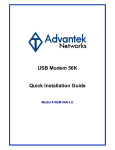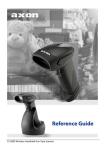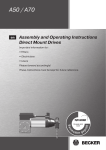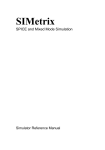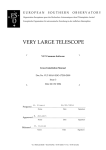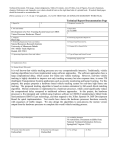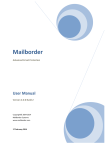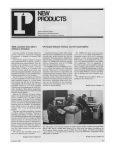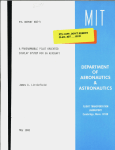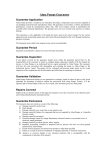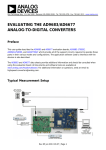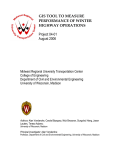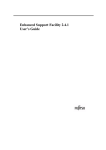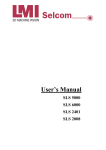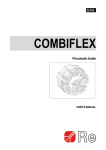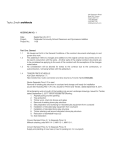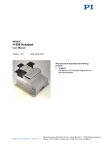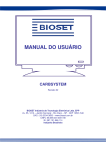Download Interface Control Document
Transcript
Interface Control Document between: AEM Antenna and: ALMA Computing, Control Software ALMA-33.00.00.00-70.35.20.00-A-ICD Version: A dated 05.08.2011 Status: Draft Prepared By: Organization Date E. Allaert and P. Martinez ESO 2011-08-05 IPT Leader Approvals: Organization Date Stefano Stanghellini ESO 2011-08-05 Gianni Raffi ESO 2011-08-05 System Engineering Approvals: Organization Date Christoph Haupt ESO 2011-08-05 Javier Marti-Canales JAO 2011-08-05 Configuration Control Board Approval: Organization ALMA Configuration Control Board Secretary, signing for the Control Board Organization Joint ALMA Office Project Director Date Javier Marti-Canales JAO Director Release Authorization: Thijs de-Graauw 2011-08-05 Date 2011-08-05 Doc # : ALMA-33.00.00.00-70.35.20.00-A-ICD ALMA Project Date: Interface Control Document 2011-08-05 Status: Draft between AEM Antenna and ALMA Computing, Control Software (Draft, Pending, Approved, Released, Superseded, Obsolete) Page: 2 of 64 Change Record Version Date Affected Section(s) A 2003-10-10 All B 2003-12-14 C 2005-11-30 Applicable documents table and header logo Sections 2, 3.1, 4.1, 4.2, 4.3, 4.4, 4.5, 5.1.1, 5.1.3.1, 5.1.3.2, 5.1.3.3, 5.1.3.4, 5.1.3.7, 5.2, 5.3, 5.5, 5.6 and 6 5.1.3.5, 5.1.3.6 and 5.6 D 2006-12-08 Sections 5.1.3.1 and 5.1.3.2 5.1.3.3 E 2007-09-06 Sections 2.1 4.2 4.2.1 4.5 5.1.3.1 5.1.3.2 5.1.3.3 5.1.3.4 5.1.3.7 5.1.3.8 5.1.4.1 Change Request # Reason/Initiation/Remarks Initial release None ALMA34.00.00.00034-B-CRE S. Oliver added in new alma logo in headers and changed all applicable documents to reference documents Clarifications and minor corrections New sections Additional subreflector mechanism tilt capability RD[01] updated to revision B Added Cabling Plan Text regarding Utility module type updated Changed from contact closed to contact open for alarms. Update 5 Stow monitor and 7 Over temperature alarm. Removed 9 48 VDC. Defined type of Utility module “power strip” removed Added ACU_TRK_MODE_RSP, GET_METR_DELTAS_TEMP, GET_METR_DELTAPATH, SELFTEST_ERR, Modified GET_METR_EQUIP_STATUS, Modified GET_METR_DISPL_N. Added ACU_TRK_MODE ACU_MODE_RSP added SELFTEST mode, Added ACU_TRK_MODE_RSP GET_ACU_ERROR, added error codes GET_METR_EQUIP_STATUS, changed to 4 bytes, added bit for blanking GET_METR_DISPL_N, changed to 4 bytes GET_METR_TEMPS_N, added sensor fault Added GET_METR_DELTAS_TEMP Added GET_METR_DELTAPATH GET_ANTENNA_TEMPS and GET_ANTENNA_TEMPS, added sensor fault values Doc # : ALMA-33.00.00.00-70.35.20.00-A-ICD ALMA Project Date: Interface Control Document Status: Draft between AEM Antenna and ALMA Computing, Control Software Version Date Affected Section(s) 5.6 5.7 AEM-F 2011-08-05 (Draft, Pending, Approved, Released, Superseded, Obsolete) Page: Change Request # 3 of 64 Reason/Initiation/Remarks Changed data for SELFTEST_RSP Added SELFTEST_ERR Added ACU_TRK_MODE Updated description for SELFTEST_CMD New section (Trajectory Commands) New section (OTP Mapping) New section (Tracking sub mode) Rewritten New section (Circular buffer) 2010.04.22 AEM-G 2011.03.15 AEM-G 2011.03.22 AEM-G 2011.04.06 GET_SERIAL_NUMBER added INIT_AZ_ENC_ABS_POS added INIT_EL_ENC_ABS_POS added GET_METR_DISPL_N eliminated (not used by AEM) SET_AIR_CONDITIONING added GET_PT_MODEL_COEFF_N confirmed SET_PT_MODEL_COEFF_N confirmed Hexapod hardware limits eliminated SELF TEST GET/SET updated GET_METR_COEFF_N added SET_METR_COEFF_N added 5.1.3.1-5.1.3.3 5.1.3.2-5.1.3.4 5.1.4 5.4 5.6 6 Monitor points general update Control points general update Emergency Stow eliminated Reference to S/W Mainten. Manual added. Self Test References added. 5.1.3.1-5.1.3.2 Minor refurbishments on the basis of ESO comments. Page numbering update on tables 5 and 6. 5.1.3.1-5.1.3.2 5.1.3.3 - GET_AZ_STATUS Automatic page numbering update inserted on tables 5 and 6. Minor refurbishments on the basis of ACRV#01 actions. - GET_EL_STATUS 5.1.3.4 - RESET_ACU_CMD_1 AEM-A New number AEM-A New number 2011.04.11 1.1 2011.07.22 5.1.3.3 Document renumbered as requested by ESO EL Stow Pins command returned Pin Added GET_AC_TEMP Added DUMP_ERROR_LOG GET_SYSTEM_STATUS updated SELFTEST_CMD_1 updated Doc # : ALMA-33.00.00.00-70.35.20.00-A-ICD ALMA Project Date: Interface Control Document Status: Draft between AEM Antenna and ALMA Computing, Control Software Version Date Affected Section(s) AEM-A New number 2011.08.05 All 2011-08-05 (Draft, Pending, Approved, Released, Superseded, Obsolete) Page: Change Request # 4 of 64 Reason/Initiation/Remarks Final refurbishments after ESO comments for official release towards ALMA ALMA Project Doc # : ALMA-33.00.00.00-70.35.20.00-A-ICD Date: Interface Control Document between AEM Antenna and ALMA Computing, Control Software 2011-08-05 Status: Draft (Draft, Pending, Approved, Released, Superseded, Obsolete) Page: 5 of 64 Table of Contents 1 DESCRIPTION............................................................................................................. 6 1.1 Purpose ....................................................................................................................... 6 2 RELATED DOCUMENTS AND DRAWINGS .......................................................... 6 2.1 Reference Documents ................................................................................................ 6 2.2 Standards .................................................................................................................... 6 3 ABBREVIATIONS AND ACRONYMS ..................................................................... 8 3.1 Glossary ..................................................................................................................... 8 4 ELECTRONIC INTERFACE ....................................................................................... 9 4.1 Computer Hardware and Software............................................................................. 9 4.2 Location ..................................................................................................................... 9 4.2.1 Utility Module .................................................................................................. 10 4.3 Monitor and Control Interface ................................................................................. 12 4.4 Timing Interface....................................................................................................... 12 4.5 Ethernet Interface ..................................................................................................... 13 5 SOFTWARE CONTROL FUNCTION INTERFACE ............................................... 13 5.1 Monitor and Control Software Interface .................................................................. 13 5.1.1 General ............................................................................................................. 13 5.1.2 Data Types ....................................................................................................... 15 5.1.3 ACU M&C Points ............................................................................................ 15 5.1.4 ACU Modes of Operation ................................................................................ 58 5.2 Reset Signal ............................................................................................................. 61 5.3 Ethernet Interface ..................................................................................................... 61 5.4 Static Parameters ...................................................................................................... 61 5.5 Non standard CAN behaviour .................................................................................. 62 5.6 Self Test ................................................................................................................... 62 5.6.1 Self Test Details ............................................................................................... 62 5.7 Circular Buffer ......................................................................................................... 63 5.7.1 Circular Buffer Details ..................................................................................... 63 6 SAFETY ISSUES ....................................................................................................... 63 ALMA Project Doc # : ALMA-33.00.00.00-70.35.20.00-A-ICD Date: Interface Control Document between AEM Antenna and ALMA Computing, Control Software 1 1.1 2011-08-05 Status: Draft (Draft, Pending, Approved, Released, Superseded, Obsolete) Page: 6 of 64 Description Purpose The purpose of this document is to define the interface between the AEM antenna and specifically its control unit and ALMA‟s monitor and control (M&C) system. This ICD provides the interface definitions for the minimum control functionality which is identified at present for the control of the antenna. Additional functionality will have to be added by the Antenna Contractor in agreement with ALMA to take into account their design, and in particular aspects linked to monitoring and safety. 2 2.1 Related Documents and Drawings Reference Documents [RD01] “ALMA Monitor and Control Bus Interface Specification”, ALMA70.35.10.03-001-B-SPE, Version B [RD02] “CAN System Engineering”, Wolfhard Lawrenz, Springer-Verlag, 1997 (Sections 1 & 2) [RD03] “Coordinate System Specification”, ALMA-80.05.00.00-009-B-SPE [RD04] “ALMA Cabling Installation Plan for AEM Antenna Contractor”, ANTD80.04.00.00-019-B-PLA [RD05] “Software Maintenance Manual Antenna Control System”, ANTD-3335030-3-027-MAN [RD06] “Software User Manual Antenna Control System”, ANTD-3335030-3-026-MAN [RD07] Antenna Control Unit Design Report ANTD-3335030-3-001-REP 2.2 Standards [RD08] ANSI/IEEE Std 1014-1987. "IEEE Standard for a Versatile Backplane Bus: VME bus." [RD09] ISO/IEC 8802-3: 1992 "Information Processing Systems - Local Area Networks - Part 3: Carrier Sense Multiple Access with Collision Detection (CSMA/CD). Access methods and Physical Layer Specifications.” Ethernet standard. ALMA Project Doc # : ALMA-33.00.00.00-70.35.20.00-A-ICD Date: Interface Control Document between AEM Antenna and ALMA Computing, Control Software 2011-08-05 Status: Draft (Draft, Pending, Approved, Released, Superseded, Obsolete) Page: 7 of 64 [RD10] ISO 11898:1993 Road vehicles - Interchange of digital information Controller area network (CAN) for high-speed communication [RD11] EIA Standard RS-485. “Standard for electrical characteristics of generators and receivers for use in balanced digital multipoint systems”. Electronic Industries Association, 1983. ALMA Project Doc # : ALMA-33.00.00.00-70.35.20.00-A-ICD Date: Interface Control Document between AEM Antenna and ALMA Computing, Control Software 3 3.1 ABM Access Mode 2011-08-05 Status: Draft (Draft, Pending, Approved, Released, Superseded, Obsolete) Page: 8 of 64 Abbreviations and Acronyms Glossary Antenna Bus Master Current mode of accessing the ACU. When in Local access mode, the ACU may only be commanded by a local handset; all commands via the CAN M&C interface are ignored except for monitor requests. When in Remote access mode, M&C commands are accepted. The ACU may not be switched from Local to Remote access mode over the CAN M&C interface. ACK Acknowledge. In a CAN transmission, this is a bit in a transmitted frames which is set by a successful receiver of the frame ACU Antenna Control Unit ALMA Atacama Large Millimeter Array AUI A type of Ethernet connector AZ Azimuth. Defined as zero to North. BE Back-End Bore sight The actual orientation of the axis of symmetry of the main reflector with respect to established local coordinates (zenith direction and nominal azimuth zero). CAN Controller Area Network CAN ID CAN message identification. A 29 bit identifier transmitted at the start of a CAN frame which also determines the frame’s priority CDR Critical Design Review EL Elevation FE Front End ICD Interface Control Document ISO International Standards Organisation LAN Local Area Network M&C Monitor and Control Operational The ACU state determining the availability of axis drive motors, and Mode brakes. Also defines how the position commands are interpreted. PCU Portable (handheld) Control Unit RTR Remote Transmission Request. A type of CAN frame requesting transmission of a particular frame TBD To Be Determined Turns One turn of an antenna axis, or 360 UPS Un-interrupted Power Supply VME VERSAbus Module European VoIP Voice over IP WVR Water Vapor Radiometer ALMA Project Doc # : ALMA-33.00.00.00-70.35.20.00-A-ICD Date: Interface Control Document between AEM Antenna and ALMA Computing, Control Software 4 4.1 2011-08-05 Status: Draft (Draft, Pending, Approved, Released, Superseded, Obsolete) Page: 9 of 64 Electronic Interface Computer Hardware and Software All embedded microprocessor systems shall be based on VME backplanes. All software shall be written for RTAI real-time Linux operating system. The exact RTAI/Linux version for the delivery of the software will be defined by ALMA, having discussed with the contractor, 6 months before provisional acceptance of the software. The source code shall be available to ALMA together with compiler and development tools. Additionally procedures for updating the ACU software remotely shall be provided. The contractor is responsible for obtaining licenses needed for RTAI or other software used. All application programming for processors in the control unit shall be written in C or C++. Executable code shall be stored in non-volatile electronic memory, avoiding mechanically driven peripherals such as disk drives. All microprocessor systems shall have Ethernet interfaces for debugging and testing. All computers on the antenna shall be fully functional in the absence of any external connection to the Ethernet network. 4.2 Location The Contractor shall locate the CAN bus interface connector (see Section 4.3) on his equipment in such a way that a cable from there to the center of the receiver room will not exceed 25 m in length, including, if necessary, the traversal of any cable wraps around the antenna motion axes. The absolute maximum length is 35m. The contractor shall provide space for an Ethernet switch (provided and mounted by ALMA) in a temperature controlled and easily accessible area, preferably the azimuth platform or pedestal room, but not in the receiver cabin. The switch shall be connected to a separate UPS power used only for the switch and the utility module, see below. The UPS power shall be provided by the contractor. A remotely operated utility module (see below) with Ethernet interface shall be mounted close to the Ethernet switch. The contractor shall procure, mount and test the utility module. Software for testing the utility module to validate its functionality shall also be provided. The Antenna Bus Master (ABM) will be provided and mounted by ALMA in the BE rack in the receiver cabin. A CAN bus shall be routed by the contractor from the ACU to the ABM in the receiver cabin. Another CAN bus shall be routed by the contractor from the ABM to the apex (the position where the subreflector is mounted). The contractor shall also route a CAN cable from the ABM to the optical telescope. ALMA Project Doc # : ALMA-33.00.00.00-70.35.20.00-A-ICD Date: Interface Control Document between AEM Antenna and ALMA Computing, Control Software 2011-08-05 Status: Draft (Draft, Pending, Approved, Released, Superseded, Obsolete) Page: 10 of 64 Place shall also be reserved for two VoIP telephones in a temperature controlled area, one in the receiver cabin and the other in the pedestal room. Figure 2: Cable Routing. For actual cabling, see [RD04] 4.2.1 Utility Module The utility module is a device to remotely through Ethernet monitor and control digital inputs and outputs. The inputs/outputs shall be galvanically isolated. The utility module shall receive the following alarm conditions and relay the status information to the Ethernet via an IP address: 1. Fire Alarm (Contact closure in normal state directly to utility module from battery- ALMA Project Doc # : ALMA-33.00.00.00-70.35.20.00-A-ICD Date: Interface Control Document between AEM Antenna and ALMA Computing, Control Software 2011-08-05 Status: Draft (Draft, Pending, Approved, Released, Superseded, Obsolete) Page: 11 of 64 operated fire sensor. Contact open in case of alarm.) 2. Emergency-stop set (Contact closure in normal state directly to utility module from emergency stop chain. Contact open if any of the emergency-stop buttons are pushed in.) 3. AC power off (Contact closure in normal state directly to utility module from AC power unit. Contact open in the event AC power is off.) 4. UPS power off (Contact closure in normal state directly to utility module from UPS power unit. Contact open in the event UPS power is off.) 5. Stow monitor (Contact closure in normal state directly to utility module from stow pins. Contact open in the event any stow pin is in.) 6. Over temperature alarm (Contact closure in normal state directly to utility module from receiver cabin and motor temperature sensors. Contact open in the event of over temperature in receiver cabin or motors.) 7. HVAC alarm (Contact closure in normal state directly to utility module from HVAC unit. Contact open in the event HVAC unit is powered down.) 8. Zenith pointing (Contact closure in normal state directly to utility module from antenna zenith pointing sensor. Contact open in the event antenna is at zenith pointing.) 9. Spare. 10. Feed shutter. Contact closure in normal state directly to utility module from feed shutter. Contact open in the event of feed shutter being open when elevation angle is above 89.0 degrees. 11. Spare (up to 12 inputs are possible with example device) Note that status information must pass directly to the utility module whether or not it also passes to a control computer. The utility module shall receive the following commands from the Ethernet IP and output a control bit to the following functions: 1. Remote set emergency stop. (Contact closure in normal state directly to emergency stop activator in ACU. Contact open to activate emergency stop. The emergency stop activation shall be independent of the ACU operation. This function MAY NOT disengage any locally set emergency stop.) Reset of this emergency stop may not change the state of the antenna. 2. Spare (Two outputs are possible with example device). In addition, for safety reasons, the input signal logic shall be „contact closure on normal state, e.g. contact open on alarm‟. The utility module must have an AC power source separate from the Antenna AC power or the main UPS power. Power must be provided for current loops for each contact closure. Type of utility module device: ADAM-6051, Data Acquisition Module, available from B&B Electronics, www.bb-elec.com. Doc # : ALMA-33.00.00.00-70.35.20.00-A-ICD ALMA Project Date: Interface Control Document Status: Draft between AEM Antenna and ALMA Computing, Control Software 4.3 2011-08-05 (Draft, Pending, Approved, Released, Superseded, Obsolete) Page: 12 of 64 Monitor and Control Interface The serial bus interfaces between ALMA‟s system and the Contractor‟s ACU and shall be a CAN bus as described in [RD01]. The connector type shall be a 9-pin D shell connector with pin allocation as given in Section 2.1.2 of [RD01]. The diagram is reproduced here and represents the bus stub connector. The ACU shall provide one female and one male connector for connection to the CAN bus making it possible to daisy chain the CAN bus. The contractor shall supply external terminator for the CAN bus to be attached to the output CAN connector. The CAN connectors shall be easily accessible when the ACU is mounted. Note that the reset signal (pins 1 and 6) and the time signal (pins 4 and 8) are nonstandard but are required. Pin 9 is defined in the CAN standard for use in supplying power to bus devices. It will not be used for this purpose within ALMA. 1 2 RSTA 3 4 CAN_L CAN_GND 6 RSTB 7 CAN_H 8 5 TIMA CAN_SHLD 9 TIMB Figure 1: CAN D-connector pin allocations. A male connector is shown, viewed from the pin side Table 1: CAN D connector pin definitions Pin 1 2 3 4 5 6 7 8 9 4.4 Signal RSTA CAN_L CAN_GND TIMA CAN_SHLD RSTB CAN_H TIMB - Description Global Slave Node Reset, line A CAN_L bus line (dominant low) CAN Ground Timing Signal, line A CAN Bus Shield Global Slave Node Reset, line B CAN_H bus line (dominant high) Timing Signal, line B Reserved Timing Interface In addition to the serial bus, the ACU will receive a precise timing reference signal on the same CAN D-connector as shown in Figure 1 and Table 1 This will be a periodic pulse, supplied by differential signaling conforming to RS485. The pulse period shall be 48 ALMA Project Doc # : ALMA-33.00.00.00-70.35.20.00-A-ICD Date: Interface Control Document between AEM Antenna and ALMA Computing, Control Software 2011-08-05 Status: Draft (Draft, Pending, Approved, Released, Superseded, Obsolete) Page: 13 of 64 milliseconds and width of 5 to 10 milliseconds, with a nominal value of 6 milliseconds. The leading edge of each pulse marks a timing event. The source will contain a RS485 transmitter, which will drive the bus to a quiescent state of logic 0 (FALSE), and will drive it to a logic 1 (TRUE) periodically with a duty cycle of 12.5 %. The period is specified to be 48.0 ms. Use of the signal at other nodes is optional, but each user node shall have a RS485 receiver that is designed so that an open circuit or short circuit is interpreted as logic 0. The leading edge (0 to 1 transition) of the signal will be accurately synchronized to ALMA array time (with a maximum error to be specified elsewhere), but the timing of the falling edge (1 to 0) is not specified. Further details are available in [RD02]. Note that the “TIMA” and “TIMB” signals shown in Figure 1 denote the RS422 A and B lines as defined in [RD08]. 4.5 Ethernet Interface The Ethernet interface, to be provided for debugging, maintenance and software updates, shall conform to [RD06]. Ethernet cables shall be routed in such a way that the bending radius allows for later installation of fiber optic cables Ethernet cabling shall be provided for the ACU, utility module and the VoIP telephones. Additionally there shall be three Ethernet connections for laptops, one in the receiver cabin, one on azimuth platform and one in the pedestal room. All Ethernet cabling within an antenna shall be shielded CAT5 twisted pair for 100 Mbit/sec unless indicated otherwise. The Ethernet switch shall be connected to another Ethernet switch in the BE rack in the receiver cabin. This cable shall be multi-mode fiber specified for 1 GBit/sec Ethernet. 5 5.1 5.1.1 Software Control Function Interface Monitor and Control Software Interface General The CAN bus in use for monitor and control by ALMA consists of the CAN 2.0B variant and a non-standard higher level protocol defined in [RD02]. CAN 2.0B specifies the extended, or 29 bit, address range for the CAN frame [RD02]. The implications of the higher level protocol will be discussed further in this section. The baud rate of the CAN bus is 1 Mbits/sec. Unless explicitly stated otherwise, all M&C values (integer, fixed or floating point) shall be transmitted in network byte order, or big endian fashion. Where specific bits in a byte are referenced in the following sections, bit 0 is the least significant bit. In accordance with [RD02], the Contractor‟s ACU CAN shall have a unique 64 bit serial number and the CAN node address 0. The node address defines a range of CAN addresses within which all of the ACU specific CAN traffic will fall. As the ACU is a special node, ALMA defines the serial number and node address as follows: Doc # : ALMA-33.00.00.00-70.35.20.00-A-ICD ALMA Project Date: Interface Control Document 2011-08-05 Status: Draft between AEM Antenna and ALMA Computing, Control Software (Draft, Pending, Approved, Released, Superseded, Obsolete) Page: 14 of 64 Table 2: ACU Bus Constants, to be updated for production antennae ACU Serial Number ACU Node Address Value (hexadecimal) Unique 64 bit serial number for each ACU 0 In the following sections, the prefix “0x” denotes that the number is hexadecimal. This implies that the ACU will respond to the Identify Node broadcast message on CAN ID 0x00000000 as defined in the following table: Table 3: ACU Bus Identify Response, to be updated for production antennae ACU receives CAN ID (hex) 00 00 00 00 ACU transmits CAN ID (hex) 00 04 00 00 With data bytes (hex) Unique 64 bit ACU serial number Note that these transmissions must begin within 1 millisecond of receiving the Identify Node broadcast message. The range of CAN IDs to which the ACU responds for M&C data will be restricted to 0x00 04 00 00 to 0x00 07 FF FF. As defined in [RD01], each defined CAN ID represents a single monitor or control point. Control points require no explicit acknowledgement beyond the implicit CAN ACK bit. Monitor data is requested by a zero-length frame (not an RTR frame) and the ACU must respond with the appropriate monitor data within 150 microseconds. If the values to be returned are not time critical, they may be returned from a local cache. All commands (control points designated by a CMD suffix) must result in success, an error or a timeout. These error conditions shall be stored on a stack, which may be polled with the GET_ACU_ERROR monitor point. This monitor request returns an error from the stack until none are left. All errors include a 1 byte code identifying the error condition or timeout and a 4 byte identification of the command which caused the error or timeout. The stack shall be big enough to contain at least 32 errors. If the stack is full new errors shall be discarded and a specific error shall indicate the stack overflow. If unexpected commands or commands or monitor points with not defined CAN id are received, an error shall be put on the error stack. The Contractor's interface shall respond correctly if up to 50 messages per 48 millisecond timing period are addressed to it. An overall message rate on the CAN bus (including messages addressed to other nodes) that uses the full 1 Mbits/sec raw data rate shall not cause any errors in the Contractor's interface. The following tables summarize all M&C points for the ACU, with their CAN ID allocations, data size and typical access rates. Each M&C point is then described in more detail after section 5.1.2, which details the data types used in the detailed descriptions. ALMA Project Doc # : ALMA-33.00.00.00-70.35.20.00-A-ICD Date: Interface Control Document between AEM Antenna and ALMA Computing, Control Software 2011-08-05 Status: Draft (Draft, Pending, Approved, Released, Superseded, Obsolete) Page: 15 of 64 Please note that this list of monitor and control points is expandable during the antenna design phase and will be frozen at the antenna CDR. 5.1.2 Data Types The following table indicates the data types used within CAN messages. Table 4: CAN Data Types Data Type Bit ubyte int8 uint8 int16 uint16 int32 uint32 float double string Description A single bit within an ubyte. Unused bits within ubytes are padded to fill the byte. An unsigned byte, usually used for bit fields. A signed 8 bit integer value. An unsigned 8 bit integer value. A signed 16 bit integer value. An unsigned 16 bit integer value. A signed 32 bit integer value. An unsigned 32 bit integer value. Single precision 32 bit IEEE floating point value. Double precision 64 bit IEEE floating point value. A string of single byte characters. Length is given by the DLC field in the CAN frame and the string is not null terminated. When multiple types are used in a single CAN message payload, there is no padding between values in a message. All values appear in the CAN message payload in network byte order, or most significant byte first. Within a byte, bit 0 is the least significant bit. 5.1.3 ACU M&C Points The following tables summarize all M&C points for the ACU, with their CAN ID allocations, data size and typical access rates. Each M&C point is then described in more detail. 5.1.3.1 Summary of ACU Monitor Points Monitor data shall be polled by the ALMA bus master according to the protocol specified in [RD01]. A monitor request consists of a transmission of the appropriate CAN message with zero bytes of data. The ACU shall respond within 150 microseconds by transmitting the requested data in a message with the same CAN identification. The “_RSP” suffix denotes a response message for which a corresponding “_CMD” control point exists. Most, but not all “GET_” monitor points have a corresponding “SET_” control point. Doc # : ALMA-33.00.00.00-70.35.20.00-A-ICD ALMA Project Date: Interface Control Document between AEM Antenna and ALMA Computing, Control Software 2011-08-05 Status: Draft (Draft, Pending, Approved, Released, Superseded, Obsolete) Page: 16 of 64 Table 5: Summary of Monitor Points Name GET_SERIAL_NUMBER ACU_MODE_RSP ACU_TRK_MODE_RSP AZ_POSN_RSP EL_POSN_RSP GET_ACU_ERROR GET_AZ_TRAJ_CMD GET_AZ_BRAKE GET_AZ_ENC GET_AZ_MOTOR_CURRENTS GET_AZ_MOTOR_TEMPS GET_AZ_MOTOR_TORQUE GET_AZ_SERVO_COEFF_N GET_AZ_STATUS GET_AZ_ENCODER_OFFSET GET_CAN_ERROR GET_EL_TRAJ_CMD GET_EL_BRAKE GET_EL_ENC GET_EL_MOTOR_CURRENTS GET_EL_MOTOR_TEMPS GET_EL_MOTOR_TORQUE GET_EL_SERVO_COEFF_N GET_EL_STATUS GET_EL_ENCODER_OFFSET GET_SYSTEM_ID GET_IDLE_STOW_TIME GET_IP_ADDRESS GET_IP_GATEWAY GET_NUM_TRANS GET_SYSTEM_STATUS GET_PT_MODEL_COEFF_N GET_SHUTTER GET_STOW_PIN CAN ID (hex)* Data Size (bytes) Typical Interval Page Number 00 04 00 00 8 00 04 00 22 00 04 00 20 00 04 00 12 00 04 00 02 00 04 00 2F 00 04 00 13 00 04 00 14 00 04 00 17 00 04 00 19 00 04 00 1A 00 04 00 15 00 04 30 20 – 00 04 30 2F 00 04 00 1B 00 04 00 1C 00 07 00 01 00 04 00 03 00 04 00 04 00 04 00 07 00 04 00 09 00 04 00 0A 00 04 00 05 00 04 30 10 – 00 04 30 1F 00 04 00 0B 00 04 00 0C 00 07 00 04 00 04 00 25 00 04 00 2D 00 04 00 38 00 07 00 02 00 04 00 23 00 04 30 40 00 04 30 5F 00 04 00 2E 00 04 00 24 2 1 8 8 0 or 5 8 1 4 4 4 4 8 (secs) Rare (at ABM startup) 5 5 0.048 0.048 0.048 Rare 5 0.048 5 5 5 Rare 8 4 4 8 1 4 4 4 4 8 5 Rare (debug) Rare 5 0.048 5 5 5 Rare 23 24 24 25 25 25 26 26 26 26 8 4 3 2 8 4 4 7 8 5 Rare Rare Rare Rare Rare (debug) 5 Rare 27 28 28 29 29 29 29 29 31 1 2 5 5 31 32 19 19 19 20 20 20 21 21 21 22 22 22 22 Doc # : ALMA-33.00.00.00-70.35.20.00-A-ICD ALMA Project Date: Interface Control Document between AEM Antenna and ALMA Computing, Control Software Name GET_STOW_PIN_1 GET_SUBREF_ABS_POSN GET_SUBREF_DELTA_POSN GET_SUBREF_LIMITS GET_SUBREF_ROTATION GET_SUBREF_STATUS GET_METR_MODE GET_METR_EQUIP_STATUS GET_METR_COEFF_N GET_METR_TEMPS_N GET_METR_TILT_N GET_METR_DELTAS GET_METR_DELTAS_TEMP GET_METR_DELTAPATH GET_POWER_STATUS GET_AC_STATUS GET_AC_TEMP GET_UPS_OUTPUT_VOLTS GET_UPS_OUTPUT_CURRENT GET_ANTENNA_TEMPS GET_SW_REV_LEVEL SELFTEST_RSP SELFTEST_ERR SELFTEST_ERR_1 2011-08-05 Status: Draft (Draft, Pending, Approved, Released, Superseded, Obsolete) Page: 17 of 64 Typical Interval Page Number 4 6 6 3 6 4 4 4 8 (secs) 5 5 5 5 Rare 5 Rare 5 Rare 32 33 33 34 35 35 36 36 37 8 8 8 8 4 2 8 4 6 6 4 3 5 6 8 5 5 0.048 0.048 0.048 5 5 Rare 5 5 5 (debug) Rare Rare Rare 37 37 38 38 38 38 39 41 41 41 41 42 42 43 43 CAN ID (hex)* Data Size (bytes) 00 04 00 21 00 04 00 26 00 04 00 27 00 04 00 28 00 04 00 2A 00 04 00 29 00 04 00 31 00 04 00 32 00 04 00 50 – 00 04 00 51 00 04 40 N 00 04 50 N 00 04 00 34 00 04 00 33 00 04 00 53 00 04 00 30 00 04 00 2C 00 04 00 2B 00 04 00 35 00 04 00 36 00 04 00 37 00 07 00 00 00 04 00 40 00 04 00 41 00 04 00 42 5.1.3.2 Summary of Control Points Control data shall be transmitted by the ALMA bus master according to the protocol specified in [RD01]. A control transaction consists of a transmission of the appropriate CAN message with data, if appropriate. The ACU shall acknowledge receipt of the control message by setting the acknowledge bits in the trailer of the CAN transmission. No further response is required. Note that command failures and error conditions are polled in the monitor message GET_ACU_ERROR. The “_CMD” suffix denotes a command message which should result in the ACU adding error or timeout message on the error stack should the command fail. All of the “SET_” control points have a corresponding “GET_” monitor point. Doc # : ALMA-33.00.00.00-70.35.20.00-A-ICD ALMA Project Date: Interface Control Document between AEM Antenna and ALMA Computing, Control Software 2011-08-05 Status: Draft (Draft, Pending, Approved, Released, Superseded, Obsolete) Page: 18 of 64 Command input parameters shall be checked for valid range and violations shall be reported on the error stack. Commands shall be rejected if not all conditions for their execution are fulfilled and an error shall be put on the error stack. Table 6: Summary of Control Points Name ACU_MODE_CMD ACU_TRK_MODE_CMD AZ_TRAJ_CMD EL_TRAJ_CMD CLEAR_FAULT_CMD RESET_ACU_CMD RESET_ACU_CMD_1 SET_AZ_BRAKE SET_AZ_SERVO_COEFF_N CAN ID (hex)* 00 04 10 22 00 04 10 20 00 04 10 12 00 04 10 02 00 04 10 21 00 04 10 2F 00 04 10 32 00 04 10 14 00 04 20 20 – 00 04 20 2F SET_AZ_SERVO_DEFAULT 00 04 10 17 INIT_AZ_ENC_ABS_POS 00 04 10 18 SET_EL_BRAKE 00 04 10 04 SET_EL_SERVO_COEFF_N 00 04 20 10 – 00 04 20 1F SET_EL_SERVO_DEFAULT 00 04 10 07 INIT_EL_ENC_ABS_POS 00 04 10 08 SET_IDLE_STOW_TIME 00 04 10 25 SET_IP_ADDRESS 00 04 10 24 SET_IP_GATEWAY 00 04 10 38 SET_PT_MODEL_COEFF_N 00 04 20 40 – 00 04 20 5F SET_STOW_PIN 00 04 10 2D SET_SUBREF_ABS_POSN 00 04 10 29 SET_SUBREF_DELTA_POSN 00 04 10 2A SUBREF_DELTA_ZERO_CMD 00 04 10 2B SET_SUBREF_ROTATION 00 04 10 28 SET_METR_MODE 00 04 10 26 SET_METR_COEFF_N 00 04 10 50 – 00 04 10 51 SET_SHUTTER 00 04 10 2E SELFTEST_CMD 00 04 10 30 SELFTEST_CMD_1 00 04 10 31 SET_AIR_CONDITIONING 00 04 10 27 DUMP_ERROR_LOG 00 04 10 70 The letter “N” is a hexadecimal digit in the range [0, F]. Data Size (bytes) 1 1 8 8 1 1 1 1 8 Typical Interval (secs) Rare Rare 0.048 0.048 Rare Rare Rare Rare Rare Page Number 1 1 1 8 Rare Rare Rare Rare 47 47 47 47 1 1 2 8 4 8 Rare Rare Rare Rare Rare Rare 48 48 48 48 48 49 2 6 6 1 6 4 8 5 0.5 0.5 0.5 Rare Rare Rare 49 49 50 50 50 51 51 1 1 1 6 1 Rare Rare Rare Rare Rare 51 52 52 53 53 44 44 44 45 45 45 46 46 46 ALMA Project Doc # : ALMA-33.00.00.00-70.35.20.00-A-ICD Date: Interface Control Document between AEM Antenna and ALMA Computing, Control Software 2011-08-05 Status: Draft (Draft, Pending, Approved, Released, Superseded, Obsolete) Page: 19 of 64 5.1.3.3 Monitor Points in Detail Name CAN ID Description Typical Interval Data GET_SERIAL_NUMBER 00 04 00 00 Return the device specific serial number 5s uint8[8] The returned number is same as the serial number returned when this device responds to an identify broadcast Name CAN ID Description Typical Interval Data ACU_MODE_RSP 00 04 00 22 Current operational and access mode information for ACU 5s 2 bytes: byte 0: Axis Modes: ubyte bits 0-3: Azimuth Mode bits 4-7: Elevation Mode Axis Mode values: 0x0 SHUTDOWN 0x1 STANDBY 0x2 ENCODER 0x3 AUTONOMOUS 0x4 SURVIVAL STOW 0x5 MAINTENANCE STOW 0x6 VELOCITY 0x7 SELFTEST byte 1 Access Mode: ubyte 0x01 LOCAL 0x02 REMOTE Name CAN ID Description Typical Interval Data ACU_TRK_MODE_RSP 00 04 00 20 Current tracking mode information for ACU 5s 1 byte: Axis Tracking Modes: ubyte Axis Tracking Mode values: 0x0 CONTINUOUS SIDEREAL TRACKING 0x1 SLEWING 0x2 FAST SWITCHING 0x3 ON THE FLY TOTAL POWER MAPPING 0x4 ON THE FLY TOTAL INTERFEROMETRIC MOSAICKING ALMA Project Doc # : ALMA-33.00.00.00-70.35.20.00-A-ICD Date: Interface Control Document between AEM Antenna and ALMA Computing, Control Software Name CAN ID Description Typical Interval Data Name CAN ID Description Typical Interval Data Name CAN ID Description Typical Interval Data 2011-08-05 Status: Draft (Draft, Pending, Approved, Released, Superseded, Obsolete) Page: 20 of 64 AZ_POSN_RSP 00 04 00 12 Position of azimuth axis in turns at the last 20.83Hz pulse and 24ms before. Note that the interpretation of the value depends on the current active mode. In ENCODER mode, the position values are uncorrected; in AUTONOMOUS mode the values have been corrected by pointing model and metrology. 48 ms 8 bytes: bytes 0-3: azimuth position at the last 20.83 Hz timing pulse bytes 4-7: azimuth position 24 ms before the last timing pulse Data format: signed, two’s complement, fixed point binary number representing angle from –1 turn to +(1–2-31) turn. EL_POSN_RSP 00 04 00 02 Position of elevation axis in turns at the last 20.83Hz pulse and 24ms before. Note that the interpretation of the value depends on the current active mode. In ENCODER mode, the position values are uncorrected; in AUTONOMOUS mode the values have been corrected by pointing model and metrology. 48 ms 8 bytes: bytes 0-3: elevation position at the last 20.83 Hz timing pulse bytes 4-7: elevation position 24 ms before the last timing pulse. Data format: signed, two’s complement, fixed point binary number representing angle from –1 turn to +(1–2-31) turn. GET_ACU_ERROR 00 04 00 2F ACU error conditions. This monitor point returns an error stack which includes an error code and an identification of the command causing the error. 48 ms 5 Bytes (0 bytes in case of no error): Error condition indicated as follows: byte 0 (ubyte): Error code: 0x00: No error; 0x01: Timeout 0x02: Invalid mode change requested 0x03: Requested position out of range 0x04: Requested velocity out of range 0x05: ACU in Local Access Mode 0x06: Invalid brake command requested ALMA Project Doc # : ALMA-33.00.00.00-70.35.20.00-A-ICD Date: Interface Control Document between AEM Antenna and ALMA Computing, Control Software Name CAN ID Description Typical Interval 2011-08-05 Status: Draft (Draft, Pending, Approved, Released, Superseded, Obsolete) Page: 21 of 64 GET_ACU_ERROR 00 04 00 2F ACU error conditions. This monitor point returns an error stack which includes an error code and an identification of the command causing the error. 48 ms 0x10:Illegal command or monitor request (undefined CAN ID) 0x11:Unexpected command or monitor request (if a command arrives when it is not allowed) 0x12: Parameter out of range 0x13: Invalid data length of command 0x14: Trajectory command delayed (if the trajectory command for TE i+2 arrives after TE i + 24 ms) 0x15: Trajectory command duplicate error (if two trajectory commands arrive within the same TE) 0x16: Error stack overflow bytes 1-4 (uint32): Relative address of CAN message triggering error condition Name CAN ID Description Typical Interval Data GET_AZ_TRAJ_CMD 00 04 00 13 Position in turns and velocity in turns/sec set with the last AZ_TRAJ_CMD. Rare 8 bytes. Bytes 0-3: Fixed point number as described in AZ_POSN_RSP representing turns. Bytes 4-7: Fixed point number representing “velocity” in turns/sec. Returns zero values if no AZ_TRAJ_CMD has been given. Name CAN ID Description Typical Interval Data GET_AZ_BRAKE 00 04 00 14 Get azimuth brake status 5s 1 byte (ubyte) 0x00: brake disengaged 0x01: brake engaged Name CAN ID Description Typical Interval GET_AZ_ENC 00 04 00 17 Position in raw encoder1 bits at last 20.83 Hz tick 48 ms 1 Mean value of all reading heads. ALMA Project Doc # : ALMA-33.00.00.00-70.35.20.00-A-ICD Date: Interface Control Document between AEM Antenna and ALMA Computing, Control Software 2011-08-05 Status: Draft (Draft, Pending, Approved, Released, Superseded, Obsolete) Page: 22 of 64 Data 4 bytes (uint32): value of azimuth encoder. A uint32 containing the raw encoder value. Name CAN ID Description Typical Interval Data GET_AZ_MOTOR_CURRENTS 00 04 00 19 Motor currents in all azimuth axis drive motors 5s 4 bytes: byte 0-1 (int16): value of commanded motor current in centi- amps byte 2-3 (int16): value of current feedback in centi-amps Name CAN ID Description Typical Interval Data GET_AZ_MOTOR_TEMPS 00 04 00 1A Motor temperatures in all azimuth axis drive motors 5s 4 bytes: byte 0 (int8): average value of motor (1st half) 2 temperature in degrees byte 1 (int8): maximum value of motor(1st half)3 temperature in degrees byte 2 (int8): average value of motor (2nd half)2 temperature in degrees byte 3 (int8): maximum value of motor(2nd half)3 temperature in degrees Name CAN ID Description Typical Interval Data GET_AZ_MOTOR_TORQUE 00 04 00 15 Applied motor torque in all azimuth axis drive motors 5s 4 bytes: byte 0-1 (int16): value of commanded motor torque in daNm byte 2-3 (int16): value of motor torque feedback in daNm Name CAN ID Description Typical Interval Data GET_AZ_SERVO_COEFF_N 00 04 30 20 – 00 04 30 2F Azimuth servo coefficients Rare 8 bytes. (double) Each message contains a different servo loop control parameter as defined by the Contractor’s implementation. 2 3 Average temperature of 10 semi-sectors in (half AZ motor) Maximum temperature of anyone of the 10 semi-sectors (half AZ motor). ALMA Project Doc # : ALMA-33.00.00.00-70.35.20.00-A-ICD Date: Interface Control Document between AEM Antenna and ALMA Computing, Control Software Name CAN ID Description Typical Interval Data 2011-08-05 Status: Draft (Draft, Pending, Approved, Released, Superseded, Obsolete) Page: 23 of 64 GET_AZ_STATUS 00 04 00 1B Status of azimuth axis 5s 8 bytes: byte 0 - limit switches (ubyte): bit0: SW CW prelimit (set = in limit) bit1: HW CW prelimit (set = in limit) bit2: HW CW final-limit (set = in limit) bit3: CW shutdown due to limit condition (set = occurred) bit4: SW CCW prelimit (set = in limit) bit5: HW CCW prelimit (set = in limit) bit6: HW CCW final-limit (set = in limit) bit7: CCW shutdown due to limit condition (set = occurred) byte 1 – interlocks(ubyte): bit0: rotation final limit bit1: axis HW interlock (set=true) bit2: override command bit3: hardstop sense + bit4: hardstop sense – bit5: sense + bit6: sense byte 2 - motors (ubyte): bit0: motor over speed (set = true) bit1: motors 1st half over current (set = true) bit2: motors 1st half overheating (set = true) bit3: motor 2nd half over current (set = true) bit4: motor 2nd half overheating (set = true) bit5: drive power on bit6: DC bus 1 bit7: DC bus 2 byte 3 - motors (ubyte): bit0: motors power-on/switch failure (set = fault) bit1: motors enable timeout (set = fault) bit2: motor 1st half fault (set = fault) bit3: motor 2n half fault (set = fault) bit4: motor drivers ready (set=Ready) bit5: encoder/Hall sensors inconsistency bit6: following error byte 4 – encoder (ubyte): ALMA Project Doc # : ALMA-33.00.00.00-70.35.20.00-A-ICD Date: Interface Control Document between AEM Antenna and ALMA Computing, Control Software Name CAN ID Description Typical Interval 2011-08-05 Status: Draft (Draft, Pending, Approved, Released, Superseded, Obsolete) Page: 24 of 64 GET_AZ_STATUS 00 04 00 1B Status of azimuth axis 5s bit0: encoder value fault (set = fault) bit1: absolute encoder position not available (set = true) bit2: encoder value validation (unset = values ok, set = values old) bit3: servo oscillation (set = true) bit4: interpolation board #1 status (set = ok) bit5: interpolation board #2 status (set = ok) byte 5 – encoder (ubyte): bit0: encoder head #1 status (set = fault) bit1: encoder head #2 status (set = fault) bit2: encoder head #3 status (set = fault) bit3: encoder head #4 status (set = fault) bit4: encoder head #5 status (set = fault) bit5: encoder head #6 status (set = fault) bit6: encoder head #7 status (set = fault) bit7: encoder head #8 status (set = fault) byte 6 – brakes (ubyte): bit0: brake position error bit1: brake wear bit2: brake local mode bit3: brake out bit4: brake disengage timeout bit5: brake engage timeout byte 7 - spare Typical Interval Data GET_AZ_ENCODER_OFFSET 00 04 00 1C Offset between raw encoder reading and azimuth position excluding contribution from pointing and metrology corrections Rare 4 bytes (int32): An int32 containing the encoder offset. Name CAN ID Description Typical Interval GET_CAN_ERROR 00 07 00 01 Number of CAN bus errors since power-up and error code of last error (debug) Name CAN ID Description ALMA Project Doc # : ALMA-33.00.00.00-70.35.20.00-A-ICD Date: Interface Control Document between AEM Antenna and ALMA Computing, Control Software 2011-08-05 Status: Draft (Draft, Pending, Approved, Released, Superseded, Obsolete) Page: 25 of 64 Name CAN ID Description Typical Interval Data GET_CAN_ERROR 00 07 00 01 Number of CAN bus errors since power-up and error code of last error (debug) 4 Bytes bytes 0-1 (uint16) count of CAN errors since power up. byte 2 (ubyte) (reserved) byte 3 (ubyte) Error code of last CAN error. Codes are those defined by Intel 82527 CAN Controller as follows: 0x00: No error 0x01: Stuff error 0x02: Form error 0x03: Ack error 0x04: Bit1 error 0x05: Bit 0 error 0x06: CRC error Name CAN ID Description Typical Interval Data GET_EL_TRAJ_CMD 00 04 00 03 Position in turns and velocity in turns/sec set with the last EL_TRAJ_CMD. Rare 8 bytes. Bytes 0-3: Fixed point number as described in EL_POSN_RSP representing turns. Bytes 4-7: Fixed point number representing “velocity” in turns/sec. Returns zero values if no EL_TRAJ_CMD has been given. Name CAN ID Description Typical Interval Data GET_EL_BRAKE 00 04 00 04 Get elevation brake status 5s 1 byte (ubyte) 0x00: brake disengaged 0x01: brake engaged Name CAN ID GET_EL_ENC 00 04 00 07 ALMA Project Doc # : ALMA-33.00.00.00-70.35.20.00-A-ICD Date: Interface Control Document between AEM Antenna and ALMA Computing, Control Software 2011-08-05 Status: Draft (Draft, Pending, Approved, Released, Superseded, Obsolete) Page: 26 of 64 Description Typical Interval Data Position in raw encoder4 bits at last 20.83 Hz tick 48 ms 4 bytes bytes 0-3 (uint32) value of elevation encoder in raw encoder bits Name CAN ID Description Typical Interval Data GET_EL_MOTOR_CURRENTS 00 04 00 09 Actual motor currents in all elevation axis drive motors 5s 4 bytes: byte 0-1 (int16): value of commanded motor current in centi- amps byte 2-3 (int16): value of current feedback in centi-amps Name CAN ID Description Typical Interval Data GET_EL_MOTOR_TEMPS 00 04 00 0A Motor temperatures in all elevation axis drive motors 5s 4 bytes: byte 0 (int8): average value of motor (1st half) 5 temperature in degrees byte 1 (int8): maximum value of motor(1st half)6 temperature in degrees byte 2 (int8): average value of motor (2nd half) 7 temperature in degrees byte 3 (int8): maximum value of motor(2nd half 8 temperature in degrees Name CAN ID Description Typical Interval Data GET_EL_MOTOR_TORQUE 00 04 00 05 Applied motor torque in all elevation axis drive motors 5s 4 bytes: byte 0-1 (int16): value of commanded motor torque in daNm byte 2-3 (int16): value of motor torque feedback in daNm Name CAN ID Description Typical Interval GET_EL_SERVO_COEFF_N 00 04 30 10 – 00 04 30 1F Azimuth servo coefficients Rare 4 Mean value of all reading heads. Average temperature of 10 semi-sectors in (half EL motor) 6 Maximum temperature of anyone of the 10 semi-sectors (half EL motor). 7 Average temperature of 10 semi-sectors in (half EL motor) 8 Maximum temperature of anyone of the 10 semi-sectors (half EL motor). 5 ALMA Project Doc # : ALMA-33.00.00.00-70.35.20.00-A-ICD Date: Interface Control Document between AEM Antenna and ALMA Computing, Control Software 2011-08-05 Status: Draft (Draft, Pending, Approved, Released, Superseded, Obsolete) Page: 27 of 64 Data 8 bytes. (double) Each message contains a different servo loop control parameter as defined by the Contractor’s implementation. Name CAN ID Description Typical Interval Data GET_EL_STATUS 00 04 00 0B Status of elevation axis 5s 8 bytes: byte 0 - limit switches (ubyte): bit0: SW UP prelimit (set = in limit) bit1: HW UP prelimit (set = in limit) bit2: HW UP final-limit (set = in limit) bit3: UP shutdown due to limit condition (set = occurred) bit4: SW DOWN prelimit (set = in limit) bit5: HW DOWN prelimit (set = in limit) bit6: HW DOWN final-limit (set = in limit) bit7: DOWN shutdown due to limit condition (set = occurred) byte 1 – interlocks(ubyte): bit0: rotation final limit bit1: axis HW interlock (set=true) bit2: override command byte 2 - motors (ubyte): bit0: motor over speed (set = true) bit1: motors 1st half over current (set = true) bit2: motors 1st half overheating (set = true) bit3: motor 2nd half over current (set = true) bit4: motor 2nd half overheating (set = true) bit5: drive power on bit6: DC bus 1 bit7: DC bus 2 byte 3 - motors (ubyte): bit0: motors power-on/switch failure (set = fault) bit1: motors enable timeout (set = fault) bit2: motor 1st half fault (set = fault) bit3: motor 2n half fault (set = fault) bit4: motor drivers ready (set=Ready) bit5: encoder/Hall sensors inconsistency bit6: following error ALMA Project Doc # : ALMA-33.00.00.00-70.35.20.00-A-ICD Date: Interface Control Document between AEM Antenna and ALMA Computing, Control Software Name CAN ID Description Typical Interval 2011-08-05 Status: Draft (Draft, Pending, Approved, Released, Superseded, Obsolete) Page: 28 of 64 GET_EL_STATUS 00 04 00 0B Status of elevation axis 5s byte 4 – encoder (ubyte): bit0: encoder value fault (set = fault) bit1: absolute encoder position not available (set = true) bit2: encoder value validation (unset = values ok, set = values old) bit3: servo oscillation (set = true) bit4: interpolation board #1 status (set = ok) byte 5 – encoder (ubyte): bit0: encoder head #1 status (set = fault) bit1: encoder head #2 status (set = fault) bit2: encoder head #3 status (set = fault) bit3: encoder head #4 status (set = fault) byte 6 – brakes (ubyte): bit0: brake position error bit1: brake wear bit2: brake local mode bit3: brake out bit4: brake disengage timeout bit5: brake engage timeout byte 7 - spare Name CAN ID Description Typical Interval Data Name CAN ID Description Typical Interval GET_EL_ENCODER_OFFSET 00 04 00 0C Offset between raw encoder reading and elevation position excluding contribution from pointing and metrology corrections Rare 4 bytes (int32): An int32 containing the encoder offset. GET_SYSTEM_ID 00 07 00 04 Get ACU hardware and software identifiers. Currently only a software revision level is supported, but could be expanded to include hardware identifiers in future. Rare ALMA Project Doc # : ALMA-33.00.00.00-70.35.20.00-A-ICD Date: Interface Control Document between AEM Antenna and ALMA Computing, Control Software 2011-08-05 Status: Draft (Draft, Pending, Approved, Released, Superseded, Obsolete) Page: 29 of 64 Data 3 Bytes byte 0 (ubyte): major revision level byte 1 (ubyte): minor revision level byte 2 (ubyte): patch level ie. 0xXX 0xYY 0xZZ is interpreted as VXX.YY.ZZ Name CAN ID Description GET_IDLE_STOW_TIME 00 04 00 25 Currently set time for ACU to enter survival stow if no communications received on CAN bus or timing pulse has ceased. Rare 2 bytes: (uint16) value representing seconds Typical Interval Data Name CAN ID Description Typical Interval Data GET_IP_ADDRESS 00 04 00 2D ACU IP address Rare 8 Bytes: bytes 0 – 3 (uint32): 32 bit IP address organized as byte1.byte2.byte3.byte4 bytes 4 - 7 (uint32): 32 bit subnet mask organized as byte1.byte2.byte3.byte4 Name CAN ID Description Typical Interval Data GET_IP_GATEWAY 00 04 00 38 ACU gateway IP address Rare 4 Bytes: bytes 0 – 3 (uint32): 32 bit gateway IP address organized as byte1.byte2.byte3.byte4 Name CAN ID Description Typical Interval Data GET_NUM_TRANS 00 07 00 02 Number of transactions handled by ACU since power up (debug) 4 Bytes: (uint32) count of handled transactions Name CAN ID Description GET_SYSTEM_STATUS 00 04 00 23 State of miscellaneous related systems ALMA Project Doc # : ALMA-33.00.00.00-70.35.20.00-A-ICD Date: Interface Control Document between AEM Antenna and ALMA Computing, Control Software Typical Interval Data 2011-08-05 Status: Draft (Draft, Pending, Approved, Released, Superseded, Obsolete) Page: 30 of 64 5s 7 Bytes byte 0 (ubyte): bit0: emergency stop (set = applied) bit1: ACU interlock (set = applied) bit2: base door interlock (set = applied) bit3 base 1 interlock (set = applied) bit4 base 2 interlock (set = applied) bit 5 AZ skirt 1 interlock (set = applied) bit6 AZ skirt 2 interlock (set = applied) bit7 acces stair 1 interlock (set = applied) byte 1 (ubyte): bit0 EL left interlock (set = applied) bit1 EL right interlock (set = applied) bit2 PCU1 RC interlock (set = applied) bit3 PCU 2 D1 interlock (set = applied) bit4 PCU 3 Base interlock (set = applied) bit5 PCU 4 PLC interlock (set = applied) bit6 receiver cabin interlock (set = applied) bit7 receiver cabin access door interlock (set = applied) byte 2 (ubyte): bit0 handrail rc platform interlock (set = applied) bit1: ACU booting failure (set = failed) bit2: survival stow due to missing commands after idle time (set=applied) bit3: survival stow due to missing timing pulse after idle time (set=applied) bit4: timing pulse missing (set=missing) bit5: ACU task failure (set=failure) bi6: timing pulse missed (set=missed)9 byte 3 (ubyte): bit0 hydraulic unit generic alarm (set = alarm) bit1 fire system status (set = fault) bit2 over temperature alarm (set = applied) bit3 ventilation skirt status (set = fault) byte 4(ubyte): bit0 antenna local mode bit1 antenna remote mode bit2 antenna pcu mode bit3 PCU platform connected bit4: PCU receiver cabin connected 9 this bit is latched and needs to be cleared with CLEAR_FAULT_CMD ALMA Project Doc # : ALMA-33.00.00.00-70.35.20.00-A-ICD Date: Interface Control Document between AEM Antenna and ALMA Computing, Control Software Name CAN ID Description Typical Interval 2011-08-05 Status: Draft (Draft, Pending, Approved, Released, Superseded, Obsolete) Page: 31 of 64 GET_SYSTEM_STATUS 00 04 00 23 State of miscellaneous related systems 5s bit5 PCU basement connected bit6 PCU4 PLC connected byte 5(ubyte) bit0 drives power (set = powered) bit1 drives (set = PLC control) bit2 hydraulic pump (set = on) bit3 skirt ventilation (set = on) bit4 skirt ventilation cmd output byte 6(ubyte) (shutter status) bit0: closing ON (set = switch ON) bit1: opening ON (set = switch ON) bit2: lock on (set = movement is enabled) bit3: timeout bit4: base ladder interlock bit5: drives lockout status (set = power off) bit6: missing dummy socket (set = missing) Name CAN ID Description Typical Interval Data Name CAN ID Description Typical Interval GET_PT_MODEL_COEFF_N 00 04 30 40 – 00 04 30 5F Pointing model coefficients to be used in autonomous mode. This is a range of consecutive identifiers reserved for getting the current value of a variable number of coefficients. Rare 8 bytes in each coefficient. Value representing arcseconds. (double) 1st elem. – IA azimuth encoder zero offset 2nd elem. – CA collimation error of electromagnetic offset 3rd elem. – NPAE non-perpendicularity of mount AZ & EL axes 4th elem. – AN azimuth axis offset (misalignment north-south) 5th elem. – AW azimuth axis offset (misalignment east-west) 6th elem. – IE elevation encoder zero offset 7th elem. – HECE gravitational flexure correction at the horizon 8th 16th elem. – reserved GET_SHUTTER 00 04 00 2E Shutter mechanism status 5s ALMA Project Doc # : ALMA-33.00.00.00-70.35.20.00-A-ICD Date: Interface Control Document between AEM Antenna and ALMA Computing, Control Software 2011-08-05 Status: Draft (Draft, Pending, Approved, Released, Superseded, Obsolete) Page: 32 of 64 Data 1 byte: (ubyte) bit0: open position (set = open) bit1: close position (set = close) bit2: motor shutter ON (set = switch ON) bit3: local system error ON (set = error) Name CAN ID Description Typical Interval Data GET_STOW_PIN 00 04 00 24 Stow pins position 5s 2 bytes byte 0 (ubyte): bit0: AZ stow pin inserted (set = inserted) bit1: AZ stow pin released (set = released) byte 1 (ubyte): 10 bit0: EL stow pin #1 inserted (set = inserted) bit1: EL stow pin #1 released (set = released) Name CAN ID Description Typical Interval Data GET_STOW_PIN_1 00 04 00 21 Stow pins position 5s 4 bytes byte 0 (ubyte): bit0: AZ stow pin inserted (set = inserted) bit1: AZ stow pin released (set = released) bit2: AZ stow pin thermal protection bit3: AZ stow pin over torque bit4: AZ stow pin deploying bit5 AZ stow pin releasing bit6 AZ stow pin timeout byte 1 (ubyte): bit0: EL stow pin #1 inserted (set = inserted) bit1: EL stow pin #1 released (set = released) bit2: EL stow pin #1 thermal protection bit3: EL stow pin #1 over torque bit4: EL stow pin #1 deploying bit5 EL stow pin #1 releasing bit6 EL stow pin #1 timeout 10 Since the AEM antenna has two EL stow pins, the logic is the following: If at least one stow pin is inserted the status is inserted. If both stow pins are released the status is released. ALMA Project Doc # : ALMA-33.00.00.00-70.35.20.00-A-ICD Date: Interface Control Document between AEM Antenna and ALMA Computing, Control Software Name CAN ID Description Typical Interval 2011-08-05 Status: Draft (Draft, Pending, Approved, Released, Superseded, Obsolete) Page: 33 of 64 GET_STOW_PIN_1 00 04 00 21 Stow pins position 5s byte 2 (ubyte) bit0: EL stow pin #2 inserted (set = inserted) bit1: EL stow pin #2 released (set = released) bit2: EL stow pin #2 thermal protection bit3: EL stow pin #2 over torque bit4: EL stow pin #2 deploying bit5 EL stow pin #2 releasing bit6 EL stow pin #2 deploying timeout byte3 bit0: stow pin auto/man (set = manual) bit1: AZ stow pin position error bit2: EL stow pin #1 position error bit3: EL stow pin #2 position error bit4: AZ stow pin centered bit5: EL stow pin centered Name CAN ID Description Typical Interval Data GET_SUBREF_ABS_POSN 00 04 00 26 Get absolute position of subreflector mechanism 5s 6 bytes bytes 0-1 (int16): X axis subreflector absolute position in m (range -32768 to 32767) bytes 2-3 (int16): Y axis subreflector absolute position in m (range -32768 to 32767) bytes 4-5 (int16): Z axis subreflector absolute position in m (range -32768 to 32767) Name CAN ID Description Typical Interval GET_SUBREF_DELTA_POSN 00 04 00 27 Get delta position of subreflector mechanism 5s ALMA Project Doc # : ALMA-33.00.00.00-70.35.20.00-A-ICD Date: Interface Control Document between AEM Antenna and ALMA Computing, Control Software 2011-08-05 Status: Draft (Draft, Pending, Approved, Released, Superseded, Obsolete) Page: 34 of 64 Name CAN ID Description Typical Interval Data GET_SUBREF_DELTA_POSN 00 04 00 27 Get delta position of subreflector mechanism 5s 6 bytes bytes 0-1 (int16): X axis subreflector delta position in m (range -32768 to 32767) bytes 2-3 (int16): Y axis subreflector delta position in m (range -32768 to 32767) bytes 4-5 (int16): Z axis subreflector delta position in m (range -32768 to 32767) Name CAN ID Description Typical Interval Data GET_SUBREF_LIMITS 00 04 00 28 Get subreflector mechanism limit status 5s 3 bytes byte 0 X axis limit status (ubyte): bit0: upper software position limit (set = exceeded) bit1: lower software position limit (set = exceeded) bit2: upper software rotational limit (set = exceeded) bit3: lower software rotational limit (set = exceeded) byte 1 Y axis limit status (ubyte): bit0: upper software position limit (set = exceeded) bit1: lower software position limit (set = exceeded) bit2: upper software rotational limit (set = exceeded) bit3: lower software rotational limit (set = exceeded) byte 2 Z axis limit status (ubyte): bit0: upper software position limit (set = exceeded) bit1: lower software position limit (set = exceeded) bit2: upper software rotational limit (set = exceeded) bit3: lower software rotational limit (set = exceeded) Hardware switch not used.11 11 Regarding the hardware limits: Each leg has it own limit switch electronics, these works only for the leg itself. If one leg runs into the limit, the power will be cut and the brake will be activated. But only the movement into the direction of hardstop is blocked. It is possible to move the leg back to the operation range. That means an INI will work. PTo be reminded that in normal operation the hexapod will never run into the hardware limit. In this case something is wrong and has to be analyzed before restart. ALMA Project Doc # : ALMA-33.00.00.00-70.35.20.00-A-ICD Date: Interface Control Document between AEM Antenna and ALMA Computing, Control Software 2011-08-05 Status: Draft (Draft, Pending, Approved, Released, Superseded, Obsolete) Page: 35 of 64 Name CAN ID Description Typical Interval Data GET_SUBREF_ROTATION 00 04 00 2A Subreflector rotation position Rare 6 Bytes: Bytes 0-1: (int16) X tip in 0.0001 degrees Bytes 2-3: (int16) Y tilt in 0.0001 degrees Bytes 4-5: (int16) Z rotation in 0.0001 degrees (optional) Name CAN ID Description Typical Interval Data GET_SUBREF_STATUS 00 04 00 29 Get subreflector mechanism status 5s 4 Bytes: byte0 (ubyte): bit0: power monitor (set = powered) bit1: over run (tape switch) bit2: initialized (set = initialized) bit3:is initializing (set = initializing procedure is running) bit4: servo state (set = servo is on) bit5: connection fault bit6: SM override byte1 motion (ubyte): bit0 strut 1 motion status (set = moving) bit1 strut 2 motion status (set = moving) bit2 strut 3 motion status (set = moving) bit3 strut 4 motion status (set = moving) bit4 strut 5 motion status (set = moving) bit5 strut 6 motion status (set = moving) byte2 controller error status (ubyte): bit0 strut 1 controller error(set = error) bit1 strut 2 controller error(set = error) bit2 strut 3 controller error(set = error) bit3 strut 4 controller error(set = error) bit4 strut 5 controller error(set = error) bit5 strut 6 controller error(set = error) byte3 actuator over temperature (if above 85 °C) bit0: hexapod temperature monitoring (set = ok) bit1: actuator #1 over temperature (set = over temperature) bit2: actuator #2 over temperature (set = over temperature) bit3: actuator #3 over temperature (set = over temperature) ALMA Project Doc # : ALMA-33.00.00.00-70.35.20.00-A-ICD Date: Interface Control Document between AEM Antenna and ALMA Computing, Control Software 2011-08-05 Status: Draft (Draft, Pending, Approved, Released, Superseded, Obsolete) Page: 36 of 64 Name CAN ID Description Typical Interval GET_SUBREF_STATUS 00 04 00 29 Get subreflector mechanism status 5s bit4: actuator #4 over temperature (set = over temperature) bit5: actuator #5 over temperature (set = over temperature) bit6: actuator #6 over temperature (set = over temperature) Name CAN ID Description GET_METR_MODE 00 04 00 31 Get metrology mode. The bits corresponding to specific devices assume that these devices will be included in the design. Rare 4 bytes: byte 0 (ubyte): bit0: standard pointing model enabled bit1: tiltmeter compensation enabled bit2: temperature compensation enabled bit3: metrology correction enabled bit4: reserved bit5: automatic sub-reflector position correction enabled bit6: encoder mount displacement sensor correction enabled bit7: reserved bytes 1-3: spares Typical Interval Data Name CAN ID Description Typical Interval Data GET_METR_EQUIP_STATUS 00 04 00 32 Get metrology status 5s 4 bytes Byte 0 (ubyte) bit0: metrology power off bit1 tiltmeter power off bit2: thermal metrology communication ok bit3: right tiltmeter communication ok bit4: left tiltmeter communication ok bit5: thermal metrology out of range bit6: right tiltmeter read out of range bit7: left tiltmeter read out of range Bytes 1-3: spare ALMA Project Doc # : ALMA-33.00.00.00-70.35.20.00-A-ICD Date: Interface Control Document between AEM Antenna and ALMA Computing, Control Software Name CAN ID Description Typical Interval Data 2011-08-05 Status: Draft (Draft, Pending, Approved, Released, Superseded, Obsolete) Page: 37 of 64 GET_METR_COEFF_N 00 04 00 50 N – 00 04 00 51 Metrology model coefficients to be used in autonomous mode Rare 8 bytes in each coefficient. Value representing arcseconds. (double) 1st elem. – AN0 (Az axis tilt to be subtracted from tiltmeter readout) 2nd elem. – AW0 (Az axis tilt to be subtracted from tiltmeter readout) Name CAN ID Description Typical Interval Data GET_METR_TEMPS_N 00 04 40 N Metrology system temperatures. There are up to 100 temperature sensors. This group of monitor points returns them in blocks of 4; that is, N is in the range 0 to 25. This assumes that sensors measuring temperatures will be included in the design. 5s 8 bytes (4 int16 values) Temperature measured by temp sensors N*4 thru N*4 + 3 (up to 100 sensors distributed across 25 CAN messages); Value is in multiples of 0.01 degree C Temperature values shall indicate if sensor is broken or disabled by returning in the monitor point an extreme value, for example the maximum or minimum value. Returned data: 299.90 deg. C: +overflow -299.90 deg. C: -overflow 299.91 deg. C: disconnected 299.92 deg. C: N/A (no sensor/sensor disabled) Name CAN ID Description Typical Interval GET_METR_TILT_N 00 04 50 N Metrology system tiltmeter readouts. There are 2 tilt values, so N is in the range 0 to 1. This assumes that sensors measuring tilt will be included in the design. 100ms ALMA Project Doc # : ALMA-33.00.00.00-70.35.20.00-A-ICD Date: Interface Control Document between AEM Antenna and ALMA Computing, Control Software Data 2011-08-05 Status: Draft (Draft, Pending, Approved, Released, Superseded, Obsolete) Page: 38 of 64 8 bytes (4 int16 values) byte 0-1: tilt(c) byte 2-3: tiltmeter N+1, tilt(s) byte 4-5: tiltmeter N+1, tilt(d) byte 6-7: tiltmeter N+1, temperature tilts: multiples of 0.01 arcsec temperatures: multiples of 0.01 degree C Name CAN ID Description Typical Interval Data Name CAN ID Description Typical Interval Data GET_METR_DELTAS 00 04 00 34 Get AZ and EL total delta correction applied by the metrology to the AZ/EL position. 48 ms 8 bytes: bytes 0-3: azimuth delta correction bytes 4-7: elevation delta correction Data format: signed, two’s complement, fixed point binary number representing angle from –1 turn to +(1–2-31) turn GET_METR_DELTAS_TEMP 00 04 00 33 Get AZ and EL total delta correction applied by the metrology due to temperature variations to the AZ/EL position. 48 ms 8 bytes: bytes 0-3: azimuth delta correction bytes 4-7: elevation delta correction Data format: signed, two’s complement, fixed point binary number representing angle from –1 turn to +(1–2-31) turn Name CAN ID Description Typical Interval Data GET_METR_DELTAPATH 00 04 00 53 Error in path length 48 ms 4 bytes (int32) value in multiples of 1nm, positive value if path length is longer than nominal value. Range: -2147.483648 to +2147.483647 mm Name CAN ID GET_POWER_STATUS 00 04 00 30 ALMA Project Doc # : ALMA-33.00.00.00-70.35.20.00-A-ICD Date: Interface Control Document between AEM Antenna and ALMA Computing, Control Software Description Typical Interval Data 2011-08-05 Status: Draft (Draft, Pending, Approved, Released, Superseded, Obsolete) Page: 39 of 64 Get power and UPS status 5s 2 bytes byte 0 (ubyte): bit0: antenna power source(reflects status of manual power switch, not set = power from ALMA, set = power from transporter) bit1: UPS line failure bit2 UPS low battery bit3 UPS alarm bit4 UPS load on bypass bit5 UPS load on inverter byte1 24VDC monitoring (ubyte): bit0: aux ready (set = ok) bit1: interface (set = ok) bit2: azimuth (set = ok) bit3: elevation (set = ok) bit4: interlocks (set = ok) Name CAN ID Description Typical Interval Data GET_AC_STATUS 00 04 00 2C Get air conditioning subsystem status 5s 8 Bytes: byte 0 (ubyte) ATU: bit0: ATU resistors overload release bti1: ATU fan overload release bit2: lack of flow alarm bit3: air recirculation devices overload release bit4: resistors safety thermostat bit5; differential pressure switch btt6: manual start/stop request bit7: fan on byte 1 (ubyte) ATU: bit0:- thermal probe S47 fault bit1: thermal probe S48 fault bit2: setpoint not reached bit3: overtemperature alarm bit4: spare bit5: spare ALMA Project Doc # : ALMA-33.00.00.00-70.35.20.00-A-ICD Date: Interface Control Document between AEM Antenna and ALMA Computing, Control Software Name CAN ID Description Typical Interval Data Status: Draft (Draft, Pending, Approved, Released, Superseded, Obsolete) Page: GET_AC_STATUS 00 04 00 2C Get air conditioning subsystem status 5s bit6: watchdog bit7: spare byte 2 (ubyte) CHILLER: bit 0: low pressure bit 1: high pressure bit 2: lack of flow alarm bit 3: pump overload release bit 4: compressor overload release bit 5: flow probe bit 6: manual start/stop request bit 7: pump on byte 3 (ubyte) CHILLER: bit 0: delivery probe fault bit 1: return probe fault bit 2: pressure sensor fault bit 3: cpr command bit 4: inverter command bit 5: anti freeze bit 6: watchdog bit 7: fan fault byte 4 (ubyte) CHILLER: bit 0: inverter fault bit 1: phase sequence fault bit 2: spare bit 3: spare bit 4: spare bit 5: spare bit 6: spare bit 7: spare byte 5 (ubyte) HVAC: bit 0: HVAC disabled bit 1: Chiller connection OK bit 2: ATU connection OK bit 3: spare bit 4: spare 2011-08-05 40 of 64 ALMA Project Doc # : ALMA-33.00.00.00-70.35.20.00-A-ICD Date: Interface Control Document between AEM Antenna and ALMA Computing, Control Software Name CAN ID Description Typical Interval Data 2011-08-05 Status: Draft (Draft, Pending, Approved, Released, Superseded, Obsolete) Page: 41 of 64 GET_AC_STATUS 00 04 00 2C Get air conditioning subsystem status 5s bit 5: spare bit 6: spare bit 7: spare bytes 6-7: (int16) Temperature of chiller sending Value is in multiples of 0.01 degree C Name CAN ID Description Typical Interval Data GET_AC_TEMP 00 04 00 2B GET HVAC calibration volume temperature sensors 5s 4 Bytes: Bytes 0-1: (int16) Temperature sensor 1 (Value is in multiples of 0.01 degree C) Bytes 2-3: (int16) ) Temperature sensor 2 (Value is in multiples of 0.01 degree C) Name CAN ID Description Typical Interval Data GET_UPS_OUTPUT_VOLTS 00 04 00 35 Output voltages by phase 5s 6 Bytes: Bytes 0-1: (int16) Output voltage phase 1 (V) Bytes 2-3: (int16) Output voltage phase 2 (V) Bytes 4-5: (int16) Output voltage phase 3 (V) Name CAN ID Description Typical Interval Data GET_UPS_OUTPUT_CURRENT 00 04 00 36 Output currents by phase 5s 6 Bytes: Bytes 0-1: (int16) Output current phase 1 (A) Bytes 2-3: (int16) Output current phase 2 (A) Bytes 4-5: (int16) Output current phase 3 (A) Name CAN ID Description Typical Interval Data GET_ANTENNA_TEMPS 00 04 00 37 Antenna temperatures 5s 4 Bytes: ALMA Project Doc # : ALMA-33.00.00.00-70.35.20.00-A-ICD Date: Interface Control Document between AEM Antenna and ALMA Computing, Control Software Name CAN ID Description Typical Interval 2011-08-05 Status: Draft (Draft, Pending, Approved, Released, Superseded, Obsolete) Page: 42 of 64 GET_ANTENNA_TEMPS 00 04 00 37 Antenna temperatures 5s Bytes 0-1: (int16) Air temperature in receiver cabin. Value is in multiples of 0.01 degree C Bytes 2-3: (int16) Temperature in pedestal. Value is in multiples of 0.01 degree C12 Temperature values shall indicate if sensor is broken or disabled by returning in the monitor point an extreme value, for example the maximum or minimum value. Returned data: 299.90 deg. C: +overflow -299.90 deg. C: -overflow 299.91 deg. C: disconnected 299.92 deg. C: N/A (no sensor/sensor disabled) Name CAN ID Description Typical Interval Data GET_SW_REV_LEVEL 00 07 00 00 Revision level of vendor ACU code (debug) 3 Bytes byte 0 (ubyte): major revision level byte 1 (ubyte): minor revision level byte 2 (ubyte): patch level ie. 0xXX 0xYY 0xZZ is interpreted as VXX.YY.ZZ Name CAN ID Description Typical Interval Data SELFTEST_RSP 00 04 00 40 Get self-test status Rare 5 Bytes: Byte 0: bit 0: self-test running (set = running) bit 1: self-test completed (set = completed) bit 2: self-test failed (set = failed) Bytes 1-2 (int16): number of failing tests Bytes 3-4 (int16): number of errors on the self-test error stack 12 The temperature of thermal sensor NR1 is returned; this sensor which is located on the base structure. The temperature of the steel structure is measured. ALMA Project Doc # : ALMA-33.00.00.00-70.35.20.00-A-ICD Date: Interface Control Document between AEM Antenna and ALMA Computing, Control Software 2011-08-05 Status: Draft (Draft, Pending, Approved, Released, Superseded, Obsolete) Page: 43 of 64 Name CAN ID Description Typical Interval Data SELFTEST_ERR 00 04 00 41 Reads one entry from the self test failure stack Rare 6 Bytes 13 Bytes 0-1 (int16): number of failed test Bytes 2-5 (float): measured value, if applicable Name CAN ID Description Typical Interval Data SELFTEST_ERR_1 00 04 00 42 Reads one entry from the self test failure stack Rare 8 Bytes 14 Bytes 0-1 (int16): number of failed test Bytes 2-3 (int16): error code 0 -> test failed no detailed information available 1 -> test not executed, due to failed previous required test 2 -> Bytes 4-7 (float): measured value, if applicable 13 14 If no error, return length is 0 If no error, return length is 0. ALMA Project Doc # : ALMA-33.00.00.00-70.35.20.00-A-ICD Date: Interface Control Document between AEM Antenna and ALMA Computing, Control Software 2011-08-05 Status: Draft (Draft, Pending, Approved, Released, Superseded, Obsolete) Page: 44 of 64 5.1.3.4 Control Points in Detail Name CAN ID Description Typical Interval Data ACU_MODE_CMD15 00 04 10 22 Set current ACU operational and access modes Rare 1 Byte: Byte 0 Axis Mode: ubyte Bits 0-3: Azimuth Mode Bits 4-7: Elevation Mode Axis Mode values: 0x0 SHUTDOWN 0x1 STANDBY 0x2 ENCODER 0x3 AUTONOMOUS 0x4 SURVIVAL STOW 0x5 MAINTENANCE STOW16 Name CAN ID Description Typical Interval Data ACU_TRK_MODE_CMD17 00 04 10 20 Current tracking mode for ACU. Rare 1 byte: Axis Tracking Modes: ubyte Axis Tracking Mode values: 0x0 CONTINUOUS SIDEREAL TRACKING 0x1 SLEWING (Similar to continuous sidereal tracking, but may allow lower gains. Normally used during preset to a new object) 0x2 FAST SWITCHING 0x3 ON THE FLY TOTAL POWER MAPPING 0x4 ON THE FLY TOTAL INTERFEROMETRIC MOSAICKING Name CAN ID AZ_TRAJ_CMD 00 04 10 12 15 16 17 While the ACU is transitioning to a particular mode, repeating the ACU_MODE command to send it to the same mode will not lead to any error (i.e. there will be no action in this case). This command is used with reduced max ACC/VEL on the drives setting for the “survival stow” condition as requested into the technical specification (ice, snow, 30m/s wind, etc.). The relevant reductions are reported into the Drive Systems and ACU Design Reports. The tracking mode is automatically set to CONTINUOUS SIDEREAL TRACKING whenever one axis switches from STANDBY to ENCODER or AUTONOMOUS ALMA Project Doc # : ALMA-33.00.00.00-70.35.20.00-A-ICD Date: Interface Control Document between AEM Antenna and ALMA Computing, Control Software Description Typical Interval Data Name CAN ID Description Typical Interval Data Name CAN ID Description Typical Interval Data Name CAN ID Description Typical Interval Data 18 2011-08-05 Status: Draft (Draft, Pending, Approved, Released, Superseded, Obsolete) Page: 45 of 64 Desired position in turns and velocity in turns/sec at 20.83 Hz tick subsequent to next. The values are treated differently depending on the ACU’s operational mode. In AUTONOMOUS mode, the values are corrected by the pointing model and possibly by metrology. In ENCODER mode, no corrections are applied. 48 ms 8 bytes. Bytes 0-3: Fixed point number as described in AZ_POSN_RSP representing turns. Bytes 4-7: Fixed point number representing “velocity” in turns/sec. EL_TRAJ_CMD 00 04 10 02 Desired position in turns and velocity in turns/sec at 20.83 Hz tick subsequent to next. The values are treated differently depending on the ACU’s operational mode. In AUTONOMOUS mode, the values are corrected by the pointing model and possibly by metrology. In ENCODER mode, no corrections are applied 48 ms 8 bytes. Bytes 0-3: Fixed point number as described in EL_POSN_RSP representing turns. Bytes 4-7: Fixed point number representing “velocity” in turns/sec CLEAR_FAULT_CMD 00 04 10 21 Clear all existing fault condition flags. Where faults are still active, the corresponding bit will still be set for status monitoring points. Where a fault condition has been rectified, the corresponding bit will no longer be set in the status monitor point. Rare 1 byte: 0x01 will be sent to activate the command 0xFF: defined as NO_ACTION RESET_ACU_CMD18 00 04 10 2F Perform a soft reboot of the ACU or peripherals Rare 1 byte: (ubyte) bit0: complete ACU and peripherals reboot bit1: metrology subsystem reboot bit2: subreflector subsystem reboot This command is only accepted when both axis are in SHUTDOWN mode. ALMA Project Doc # : ALMA-33.00.00.00-70.35.20.00-A-ICD Date: Interface Control Document between AEM Antenna and ALMA Computing, Control Software 2011-08-05 Status: Draft (Draft, Pending, Approved, Released, Superseded, Obsolete) Page: 46 of 64 Name CAN ID Description Typical Interval Data RESET_ACU_CMD_119 00 04 10 32 Perform a soft reboot of the ACU or peripherals Rare 1 byte: (ubyte) bit0: complete ACU and peripherals reboot bit1: metrology subsystem reboot bit2: subreflector subsystem reboot bit3:AZ drives reset20 bit4: EL drives reset21 bit5: subreflector subsystem reboot with tape switch override22 bit 6: TE re-synch command bit 7: Encoders-Hall sensors inconsistency, error clear command23 Name CAN ID Description SET_AZ_BRAKE 00 04 10 14 Engage or disengage azimuth brake. This command should be rejected if setting the brake will damage the antenna (if for example the antenna is moving). Rare 1 byte: (ubyte) 0x00: disengage brake 0x01: engage brake 0xFF: defined as NO_ACTION Typical Interval Data Name CAN ID Description Typical Interval Data 19 20 21 22 23 24 SET_AZ_SERVO_COEFF_N24 00 04 20 20 – 00 04 20 2F Azimuth servo coefficients. These values should not be persistent and should default to static “safe” values when the ACU is rebooted. Rare 8 bytes. (double) Each message contains a different servo loop control parameter as defined by the Contractor’s implementation. This command is only accepted when both axis are in SHUTDOWN mode After this command, a CLEAR_FAULT_CMD shall be sent. Same as note 20. When the Subreflector mechanism accidentally goes to the final limit tape, no further operation is possible. This command runs a routine to bring the Hexapod again into the center This is a maintenance command before issuing this command a check on what happened must be performed. Same as note 20. This command is not a direct value assignment and it takes about 20ms time before the value can be checked with its related monitor point ALMA Project Doc # : ALMA-33.00.00.00-70.35.20.00-A-ICD Date: Interface Control Document between AEM Antenna and ALMA Computing, Control Software 2011-08-05 Status: Draft (Draft, Pending, Approved, Released, Superseded, Obsolete) Page: 47 of 64 Name CAN ID Description Typical Interval Data SET_AZ_SERVO_DEFAULT 00 04 10 17 Reset azimuth servo coefficients to default “safe” values Rare 1 byte: (ubyte) 0x01: Set servo coefficients to default values. 0xFF is defined as NO_ACTION Name CAN ID Description Typical Interval Data INIT_AZ_ENC_ABS_POS 00 04 10 18 Starts the automatic routine to determine the azimuth encoder absolute position Rare 1 byte: (ubyte) 0x01:Starts automatic routine 0xFF: defined as NO_ACTION Name CAN ID Description SET_EL_BRAKE 00 04 10 04 Engage or disengage elevation brake. This command should be rejected if setting the brake will damage the antenna (if for example the antenna is moving). Rare 1 byte: (ubyte) 0x00: disengage brake 0x01: engage brake 0xFF: defined as NO_ACTION Typical Interval Data Name CAN ID Description Typical Interval Data 25 SET_EL_SERVO_COEFF_N25 00 04 20 10 – 00 04 20 1F Elevation servo coefficients. These values should not be persistent and should default to static “safe” values when the ACU is rebooted. Rare 8 bytes. (double) Each message contains a different servo loop control parameter as defined by the Contractor’s implementation. This command is not a direct value assignment and it takes about 20ms time before the value can be checked with its related monitor point ALMA Project Doc # : ALMA-33.00.00.00-70.35.20.00-A-ICD Date: Interface Control Document between AEM Antenna and ALMA Computing, Control Software Name CAN ID Description Typical Interval Data 2011-08-05 Status: Draft (Draft, Pending, Approved, Released, Superseded, Obsolete) Page: 48 of 64 SET_EL_SERVO_DEFAULT 00 04 10 07 Reset elevation servo coefficients to default “safe” values Rare 1 byte: (ubyte) 0x01: Set servo coefficients to default values. 0xFF: defined as NO_ACTION INIT_EL_ENC_ABS_POS 00 04 10 08 Starts the automatic routine to determine the elevation encoder absolute position Typical Interval Rare 1 byte: (ubyte) Data 0x01:Starts automatic routine 0xFF: defined as NO_ACTION Name CAN ID Description Name CAN ID Description Typical Interval Data SET_IDLE_STOW_TIME 00 04 10 25 Time for ACU enter survival stow if no communications received on CAN bus or timing pulse has ceased. Rare 2 bytes: (uint16) Value representing seconds. Setting the value to 0 turns this feature off. Name CAN ID Description Typical Interval Data SET_IP_ADDRESS26 00 04 10 24 Set the new ACU IP address Rare 8 bytes: bytes 0 - 3 (uint32): 32 bit IP address organized as byte1.byte2.byte3.byte4 bytes 4 - 7 (uint32): 32 bit subnet mask organized as byte1.byte2.byte3.byte4 Name CAN ID Description SET_IP_GATEWAY27 00 04 10 38 Set the new ACU gateway IP address 26 27 SET_IP_ADDRESS: see SET_IP_GATEWAY footnote. SET_IP_GATEWAY: this command, as the SET_IP_ADDRESS, works by changing the network configuration file which is used at boot-time. Therefore, this command should be followed by a reboot, to make it effective. As it takes some time (up to 1 second) to process this command, the ACU should not be rebooted immediately after the SET_IP* command(s). ALMA Project Doc # : ALMA-33.00.00.00-70.35.20.00-A-ICD Date: Interface Control Document between AEM Antenna and ALMA Computing, Control Software Typical Interval Data Name CAN ID Description Typical Interval Data Name CAN ID Description Typical Interval Data Name CAN ID Description 28 Rare 4 bytes: bytes 0 - 3 (uint32): byte1.byte2.byte3.byte4 2011-08-05 Status: Draft (Draft, Pending, Approved, Released, Superseded, Obsolete) Page: 49 of 64 32 bit gateway IP address organized as SET_PT_MODEL_COEFF_N 00 04 20 40 – 00 04 20 5F Pointing model coefficients to be used in autonomous mode. This is a range of consecutive identifiers reserved for setting a variable number of coefficients for the antenna. These values should not be persistent and should default to static “safe” values when the ACU is rebooted. This assumes that sensors measuring displacement will be included in the design. Rare 8 bytes in each coefficient. Value representing arcseconds. (double) 1st elem. – IA azimuth encoder zero offset 2nd elem. – CA collimation error of electromagnetic offset 3rd elem. – NPAE non-perpendicularity of mount AZ & EL axes 4th elem. – AN azimuth axis offset (misalignment north-south) 5th elem. – AW azimuth axis offset (misalignment east-west) 6th elem. – IE elevation encoder zero offset 7th elem. – HECE gravitational flexure correction at the horizon 8th 16th elem. – reserved SET_STOW_PIN 00 04 10 2D Insert or release the azimuth and/or elevation stow pins. The command data could be a combination (by OR operator) of the reported values Rare 2 bytes byte 0 (ubyte): 0x01: insert AZ stow pin 0x02: release AZ stow pin byte 1 (ubyte):28 0x01: insert EL stow pins 0x02: release EL stow pins SET_SUBREF_ABS_POSN 00 04 10 29 Set the new subreflector absolute position. Setting an absolute position shall reset any delta position The command acts on both stow pins. ALMA Project Doc # : ALMA-33.00.00.00-70.35.20.00-A-ICD Date: Interface Control Document between AEM Antenna and ALMA Computing, Control Software 2011-08-05 Status: Draft (Draft, Pending, Approved, Released, Superseded, Obsolete) Page: 50 of 64 Typical Interval Data 0.5 6 bytes bytes 0-1 (int16): new X axis subreflector desired absolute position in m (range -32768 to 32767) bytes 2-3 (int16): new Y axis subreflector desired absolute position in m (range -32768 to 32767) bytes 4-5 (int16): new Z axis subreflector desired absolute position in m (range -32768 to 32767) Name CAN ID Description Typical Interval Data SET_SUBREF_DELTA_POSN 00 04 10 2A Set the new subreflector delta position 0.5 6 bytes bytes 0-1 (int16): new X axis subreflector desired delta position in m (range -32768 to 32767) bytes 2-3 (int16): new Y axis subreflector desired delta position in m (range -32768 to 32767) bytes 4-5 (int16): new Z axis subreflector desired delta position in m (range -32768 to 32767) Name CAN ID Description SUBREF_DELTA_ZERO_CMD 00 04 10 2B Reset the subreflector: setting the subreflector to the absolute position and clearing the delta position 0.5 1 bytes (ubyte) 0x01: perform the command 0xFF is defined as NO_ACTION Typical Interval Data Name CAN ID Description Typical Interval Data 29 SET_SUBREF_ROTATION29 00 04 10 28 Rotation control of subreflector 0.5 s 6 Bytes: Bytes 0-1: (int16) X tip in 0.0001 degrees (range ±1.5deg) The parameter range-check is performed by the hexapod control task, and it may take up to 2s before an out-of-range error is reported onto the ACU error stack. ALMA Project Doc # : ALMA-33.00.00.00-70.35.20.00-A-ICD Date: Interface Control Document between AEM Antenna and ALMA Computing, Control Software 2011-08-05 Status: Draft (Draft, Pending, Approved, Released, Superseded, Obsolete) Page: 51 of 64 Bytes 2-3: (int16) Y tilt in 0.0001 degrees (range ±1.5deg) Bytes 4-5: (int16) not used Name CAN ID Description Typical Interval Data SET_METR_MODE 00 04 10 26 Enable or disable the metrology encoder value correction Rare 4 bytes: byte 0 (ubyte): bit0: standard pointing model enable/disable (1=enable 0=disable) bit1: tiltmeter compensation enable/disable bit2: temperature compensation enable/disable bit3: metrology correction enable/disable bit4: spare bit5: automatic sub-reflector position correction enable/disable bit6: encoder mount displacement sensor correction enable/disable bit7: reset wind metrology reference to zero bytes 1 – 3: (spare) Name CAN ID Description Typical Interval Data SET_METR_COEFF_N 00 04 10 50 N – 00 04 10 51 Metrology model coefficients to be used in autonomous mode. These values should not be persistent and should default to static “safe” values when ACU is rebooted Rare 8 bytes in each coefficient. Value representing arcseconds (double) 1st elem. – AN0 (Az axis tilt to be subtracted from tiltmeter readout) 2nd elem. – AW0 (Az axis tilt to be subtracted from tiltmeter readout) Name CAN ID Description Typical Interval Data SET_SHUTTER 00 04 10 2E Set position of computer actuated shutter Rare 1 byte: (ubyte) 0x00: close shutter 0x01: open shutter 0xFF: defined as NO_ACTION ALMA Project Doc # : ALMA-33.00.00.00-70.35.20.00-A-ICD Date: Interface Control Document between AEM Antenna and ALMA Computing, Control Software Name CAN ID Description Typical Interval Data Name CAN ID Description Typical Interval Data 2011-08-05 Status: Draft (Draft, Pending, Approved, Released, Superseded, Obsolete) Page: 52 of 64 SELFTEST_CMD 00 04 10 30 Execute self test This command is accepted in Shutdown mode only. Rare 1 byte: (ubyte) 0x01: ACU (AZ, EL) starts FULL self test. (command accepted only in Shutdown mode) 0xFF is defined as NO_ACTION SELFTEST_CMD_1 00 04 10 31 Execute self test This command is accepted in Shutdown mode only. Rare 1 byte: (ubyte) 0x00: abort self test 0xFE: ACU (AZ, EL) starts FULL self test. (command accepted only in Shutdown mode) 0x01: ACU properly booted (get) 0x02: Power 0x03: AZ Encoder interface 0x04: AZ Drives interface 0x05: AZ Brakes 0x06: AZ Move 0x07: AZ Encoder Init 0x08: AZ End Stops 0x09: AZ Stow Pin 0x09: Tiltmeters (Metrology) 0x0A: AZ Axis Attitude 0x0B: EL Encoder interface 0x0C: EL Drives interface 0x0D: EL Brakes 0x0E: EL Move 0x0F: EL Encoder Init 0x10: EL Balancing 0x11: EL End Stops 0x12: EL Stow Pins 0x13: Feed Shutter 0x14: Subreflector Mechanism 0x15: AZ Skirt ventilation 0x16: Smoke Detectors System 0x17: HVAC system ALMA Project Doc # : ALMA-33.00.00.00-70.35.20.00-A-ICD Date: Interface Control Document between AEM Antenna and ALMA Computing, Control Software Name CAN ID Description Typical Interval Name CAN ID Description Typical Interval Data 2011-08-05 Status: Draft (Draft, Pending, Approved, Released, Superseded, Obsolete) Page: 53 of 64 SELFTEST_CMD_1 00 04 10 31 Execute self test This command is accepted in Shutdown mode only. Rare 0x18: Thermal Sensors (Metrology) 0x19: UPS 0xFF: defined as NO_ACTION SET_AIR_CONDITIONING 00 04 10 27 AIR conditioning control Rare Bytes 6: Byte 1: (ubyte) bit0: HVAC enable (general command) bit1: HVAC disable (general command) bit2: ATU enable bit3: ATU disable bit4: Chiller enable bit5: Chiller disable bit6: ATU alarm reset bit7: Chiller alarm reset byte 2: (ubyte) bit0: change ATU temperature set point bit1 change Chiller temperature set poing bytes 3-4: (int16) Air temperature of receiver cabin. Value is in multiples of 0.01 degree C (the corresponding bit in byte0 must be set) bytes 5-6: (int16) Temperature of chiller (water-glycol mixture) Value is in multiples of 0.01 degree C (the corresponding bit in byte 2 must be set) Name CAN ID Description Typical Interval DUMP_ERROR_LOG 00 04 10 70 Error log dump and buffer control Rare ALMA Project Doc # : ALMA-33.00.00.00-70.35.20.00-A-ICD Date: Interface Control Document between AEM Antenna and ALMA Computing, Control Software Data 30 2011-08-05 Status: Draft (Draft, Pending, Approved, Released, Superseded, Obsolete) Page: 54 of 64 1 byte: (ubyte) 0x01: Dump error log (dump will be done to /var/log/ACU/error.log) 0x02: Diagnostic buffer dump (dump will be done to /var/log/ACU/bufX30) 0x03: Diagnostic buffer setup31 0xFF is defined as NO_ACTION /var/log/ACU/bufX: here X stays for a number going from 0 to 15. 16 is the number of available buffers. At each dump command the previous dumped data will be overwritten. 31 For detail of configuration file refer to the Software Maintenance Manual ALMA Project Doc # : ALMA-33.00.00.00-70.35.20.00-A-ICD Date: Interface Control Document between AEM Antenna and ALMA Computing, Control Software 5.1.3.5 2011-08-05 Status: Draft (Draft, Pending, Approved, Released, Superseded, Obsolete) Page: 55 of 64 ACU Position Request Timing The monitor requests AZ_POSN_RESP and EL_POSN_RESP are specified to return the position at the last 20.83Hz pulse (here illustrated as TE) and 24 ms before. The timing of monitor requests is specified in [RD01]. Figure 2 below illustrates the timing. Figure 2: ACU Position Request Timing 5.1.3.6 ACU Trajectory Command Timing The control commands AZ_TRAJ_CMD and EL_TRAJ_CMD are specified to send the desired position and velocity to the ACU for the 20.83 tick subsequent to the next. The 20.83 ticks are here illustrated as TE. The timing of control commands are specified in [RD01]. Figure 3 below illustrates the timing. ALMA Project Doc # : ALMA-33.00.00.00-70.35.20.00-A-ICD Date: Interface Control Document between AEM Antenna and ALMA Computing, Control Software 2011-08-05 Status: Draft (Draft, Pending, Approved, Released, Superseded, Obsolete) Page: 56 of 64 Figure 3: ACU Trajectory Command Timing If the _TRAJ_CMD (#1) at for example TE i arrives to the ACU after the 24 ms command window, the ACU shall still try to apply it so that the antenna can reach the desired position at TE i+2. In this case, the ACU shall notify the ABM by putting a “trajectory command delayed error” onto the error stack. If it is too late to apply the command for TE i+2, the ACU may schedule it for one TE later (TE i+3). If the ACU receives another trajectory command (#2) just after TE i+1valid for TE i+3, then it shall discard the one which arrived too late to be valid for TE i+2 (#1) and apply the correct one (#2). If the ACU receives more than one trajectory command in one TE window, only the first one is valid and all other commands shall be discarded. The ACU shall put a “trajectory command duplicate error” onto the error stack for each discarded command. 5.1.3.7 ACU Trajectory Commands The trajectory commands sent to the ACU (AZ_TRAJ_CMD or EL_TRAJ_CMD) contains position and velocity for the antenna to reach on the second time event (TE) after the command was sent to the ACU. If the velocity given is not consistent with the position then ALMA Project Doc # : ALMA-33.00.00.00-70.35.20.00-A-ICD Date: Interface Control Document between AEM Antenna and ALMA Computing, Control Software 2011-08-05 Status: Draft (Draft, Pending, Approved, Released, Superseded, Obsolete) Page: 57 of 64 the antenna shall try to reach the commanded position as soon as possible respecting the velocity and acceleration limits. 5.1.3.8 ACU Trajectory Command during OTP Mapping and Interferometric Mapping In order to facilitate for the antenna to follow the path of the OTP Mapping and Interferometric Mapping the ABM will generate a special path for the ACU to indicate the coming turnaround. After the time tk the ACU trajectory commands will leave the commanded track and jump to the extrapolated datapoints (intermediate datapoints, violet path) from the track after the turnaround, see figure 4 below. The following conditions apply : Trajectory commands sent to the ACU (AZ_TRAJ_CMD or EL_TRAJ_CMD) contains position and velocity of the target The ACU is set to tracking mode (ENCODER or AUTONOMOUS) and subtracking mode ON THE FLY TOTAL POWER MAPPING or ON THE FLY TOTAL INTERFEROMETRIC MAPPING Fig 4: ABM trajectory commands during Turnaround The time tk in figure 4 is 9 timing events (TE) or appr. 0.4 seconds before the turnaround and tk+tret is 9 TEs after the turnaround. The trajectory at tk+1 is on the extrapolated path (violet path) after the turnaround although the turnaround has not occurred yet. This is to signal to the ACU that the turnaround will come. The antenna shall not follow the interpolated path but try to follow the intended path (motion profile, blue path) as close as possible, see motion profile calculated by ACU in figure 4. The commanded velocity of the trajectory at tk+1 is equal to –velocity at tk. ALMA Project Doc # : ALMA-33.00.00.00-70.35.20.00-A-ICD Date: Interface Control Document between AEM Antenna and ALMA Computing, Control Software 2011-08-05 Status: Draft (Draft, Pending, Approved, Released, Superseded, Obsolete) Page: 58 of 64 5.1.3.9 Other Signals The contractor shall provide details on the procedure for setting encoder zeros and any other encoder calibration required. Monitor and control messages required to support such procedures shall be negotiated between the Contractor and ALMA during the design phase. The contractor shall provide the algorithm for calculating from the raw encoder value the fully corrected antenna position given by GET_AZ/EL_POSN_RSP. If there are other parameters than the encoder offset needed for these calculations then monitor points to make them accessible shall be added. For actions not terminating instantaneously there shall be an indication in a monitor point when it has terminated. 5.1.4 ACU Modes of Operation At any time, the ACU may be in one and only one of the following operating modes: Shutdown: brakes set, no power to motors Standby: ready to drive, brakes set Velocity: rate loop driving of axes from local handset Encoder: drive so encoders equal commanded position Autonomous: drive so boresight equals commanded position. That is, the commanded position is corrected by the pointing model and any activated metrology.32 Survival Stow: drive to survival stow position Maintenance Stow: drive to maintenance stow position Simultaneously, the ACU may be in either of two access modes, Local or Remote. When remote access is selected, the controller responds to a set of commands via the CAN bus as defined in Section 5.1.3 above. When Local access is selected, commands received from the digital interface are ignored (but monitor requests are still accepted and processed) and the antenna may be controlled using the local control panel. Switching between Local and Remote access may be done only from the local control panel. Upon changing to Local or Remote access mode and at power-up and reset, the controller automatically enters the Shutdown operating mode in both axes. Not all operating modes may be entered from either access mode; see Table 8. In addition, Survival Stow mode or Shutdown may be entered automatically when the ACU detects certain fault conditions, regardless of the selected access mode. This is reflected in the Auto column of Table 8. 32 Metrology correction needs to be requested explicitly it is not automatic. ALMA Project Doc # : ALMA-33.00.00.00-70.35.20.00-A-ICD Date: Interface Control Document between AEM Antenna and ALMA Computing, Control Software 2011-08-05 Status: Draft (Draft, Pending, Approved, Released, Superseded, Obsolete) Page: 59 of 64 Table 8: Modes of Operation Operating Mode Shutdown Standby Active Modes Velocity Encoder Autonomous Survival Stow Maintenance Stow Yes Yes Mode Allowed? Remote Yes Yes Yes No Yes Yes No Yes Yes No Yes Yes Yes Yes No No No Yes No Local Auto The following rules govern changes of mode: From Shutdown mode, the only change permitted is to Standby mode, and then only if no fault conditions exist An active mode (Velocity, Encoder, Autonomous, Survival Stow, Maintenance Stow) may only be entered from Standby mode From Survival Stow mode, Shutdown mode is automatically entered upon reaching the stow position and the stow pins are inserted. From Maintenance Stow mode, Shutdown mode is automatically entered upon reaching the stow position and the stow pins are inserted. When Standby is entered, stow pins shall be automatically released. No additional stow-pin removal commands are required to enter Standby. Any of the “SET_” control messages defined in Section 5.1.3 shall be accepted in any of the operating modes, provided the ACU is in remote mode, unless there are safety issues involved. All monitor messages (Section 5.1.3) shall be handled regardless of the current operating or access mode. The following table shows which “_CMD” control messages shall be applicable in which operating modes (Remote access mode only). ALMA Project Doc # : ALMA-33.00.00.00-70.35.20.00-A-ICD Date: Interface Control Document between AEM Antenna and ALMA Computing, Control Software 2011-08-05 Status: Draft (Draft, Pending, Approved, Released, Superseded, Obsolete) Page: 60 of 64 Table 9: Commands allowed by Operating Mode Axis Operating Mode Shutdown Standby Velocity Encoder Autonomous Survival Stow Maintenance Stow Commands Accepted ACU_MODE_CMD RESET_ACU_CMD ACU_MODE_CMD None ACU_MODE_CMD AZ_TRAJ_CMD EL_TRAJ_CMD ACU_MODE_CMD AZ_TRAJ_CMD EL_TRAJ_CMD ACU_MODE_CMD RESET_ACU_CMD33 ACU_MODE_CMD RESET_ACU_CMD34 5.1.4.1 Tracking Sub-mode The tracking sub-mode is only changed by a new command ACU_TRK_MODE, a new ACU mode set with ACU_MODE_CMD, reset or reboot of the ACU. Default value is 0 = CONTINUOUS SIDEREAL TRACKING. The tracking mode is only valid in ENCODER or AUTONOMOUS mode. If the ACU_TRK_MODE command is sent when not in AUTONOMOUS or ENCODER mode an error shall be added to the error stack and the ACU shall ignore the command. The antenna should be able to transition from one sub-mode at any time. If the ABM sends trajectories which are not compatible with the defined sub-mode, an error should be raised but the ACU should nevertheless meet the commanded trajectory with degraded performance. The ACU shall directly follow the trajectory commands sent in all sub-modes. 33 34 This command cannot be executed during motion because it use the encoder mode, therefore it shall be eliminated from this table. This command cannot be executed during motion because it use the encoder mode, therefore it shall be eliminated from this table. ALMA Project Doc # : ALMA-33.00.00.00-70.35.20.00-A-ICD Date: Interface Control Document between AEM Antenna and ALMA Computing, Control Software 5.2 2011-08-05 Status: Draft (Draft, Pending, Approved, Released, Superseded, Obsolete) Page: 61 of 64 Reset Signal The ACU shall initiate a reset of the CAN interface circuitry and reboot the ACU when a 1 ms differential RS485 logical “1” pulse is detected on the CAN bus reset pins (pins 1 and 6 as defined in [RD01]). Note that the “RSTA” and “RSTB” signals shown in Figure 1 denote the RS422A and B lines defined in [RD08]. Note that this reset pulse is not a CAN standard. 5.3 Ethernet Interface In addition to the monitor and control interface provided by the CAN bus, ALMA requires that the ACU also provide an Ethernet interface to facilitate debugging and testing of the vendor equipment. In particular, is shall be possible via the Ethernet interface to 5.4 download new versions of the software. Installing a new software version shall only be possible when any of the antenna interlocks (emergency stop) pushbuttons is active. for debug, configure and profile the ACU software issue a reset command to soft boot the ACU. The reset shall only be possible when the antenna is in shutdown mode. Static Parameters The contractor shall in general face the problem of replacement of units (like the ACU, motors etc.) and shall propose a solution for downloading the correct set of parameters relevant to the replaced unit. Other static parameters to which ALMA requires access: Antenna hardware specific parameters (dependent on the Contractors specific implementation) Control loop parameters (generally those corresponding to the rare control points in Section 5.1.3.2. above, which are normally fixed at commissioning, but which may require alteration as components such as motors and encoders are replaced). XXX software version should be compiled Software parameters such as software version numbers, ACU serial number, antenna number and the CAN node number. ALMA requires the Contractor to provide access to these parameters and procedures for changing them remotely. It is permissible for such alterations to be made over the CAN bus or Ethernet interface. The exact list of static parameters and the methods for altering them are TBD during the design phase. Details are reported in Software Maintenance Manual ANTD-3335030-3-027-MAN. ALMA Project Doc # : ALMA-33.00.00.00-70.35.20.00-A-ICD Date: Interface Control Document between AEM Antenna and ALMA Computing, Control Software 5.5 2011-08-05 Status: Draft (Draft, Pending, Approved, Released, Superseded, Obsolete) Page: 62 of 64 Non standard CAN behaviour The following behavior is required of the ACU but is not standard to the CAN specification: 5.6 Pin 1 and 6 of the CAN connector are used for a remote reset pulse. The presence of a differential RS485 logical “1” on these pins for 1 millisecond should cause the ACU to reset the CAN bus interface circuitry and reboot the ACU. The bus will in a master/slave fashion under the control of ALMA‟s bus master. The Contractor‟s ACU shall not initiate transmissions on the CAN bus unless polled by ALMA‟s bus master. Self Test The ACU performs self-test at the time of power-up The ACU performs a status check at the time of power-up but does not perform any active test. RESET_ACU_CMD does not start self test. When it receives SELFTEST_CMD it performs a more detailed self-test. While self test is running the ACU does not respond to any commands except SELFTEST_RSP. If self test failed the ACU notifies the ABM using SELFTEST_RSP and pushes any error into the self-test error stack. Selftest shall only be accepted in shutdown mode. The self-test over the CAN interface shall check the status of all devices and sensors. During execution of the self-test other operating modes may be activated as appropriate, but the mode reported by ACU_MODE_RSP shall be SELFTEST during the entire operation of this test whether drives are activated or not. After completion of the self-test the ACU shall return to SHUTDOWN mode. The selftest over the CAN interface can only return limited amount of information due to limited message length (8 bytes). Therefore a more detailed selftest log shall be available over the Ethernet interface.35 Details TBD with the contractor. 5.6.1 Self Test Details All the details regarding the actions performed by this command are reported into the ACU Design Report (ANTD-333503-3-001-REP). 35 Note that the test type performed via CAN is the same as the one performer locally, just the logging is less detailed. Additionally it shall be noticed that during self-test execution the ACU responds to all commands as usually, of course safety aspects are checked. But it shall be noticed that improper commands could bring to a failure of a self test. ALMA Project Doc # : ALMA-33.00.00.00-70.35.20.00-A-ICD Date: Interface Control Document between AEM Antenna and ALMA Computing, Control Software 5.7 2011-08-05 Status: Draft (Draft, Pending, Approved, Released, Superseded, Obsolete) Page: 63 of 64 Circular Buffer The ACU shall store the positions readings in a circular buffer sufficient to hold data from for at least 10 seconds. The position data shall be at least the position sampled at each timing event (TE) and at the midpoint between 2 TEs. The circular buffer shall be stored in a local file on RAM disk. It shall be possible to copy the RAM disk file to an ALMA workstation via ftp or ssh. Format of the file TBD with the contractor. 5.7.1 Circular Buffer Details All the details regarding this diagnostic utility are reported into the ACU Design Report (ANTD-333503-3-001-REP). 6 Safety Issues Sufficient safety features and interlocks shall be provided by the contractor such that no malfunctioning ALMA interface or software can cause equipment damage or endanger human safety. ALMA software shall monitor and report situations which are approaching or reaching safety limits. In normal operation, ALMA software shall attempt to prevent the activation of hardware limits to provide a second level of safety margins and to reduce the possibility of reaching such hardware limits. Automatic hardware fail-safe mechanisms shall be applied when limits have been reached and ALMA software shall be able to monitor these. Actions not performed instantaneously shall be monitored by a timeout and timeout errors shall be reported. Example of such actions are mode switching, insertion of stow pins, moving to stow position. All variables and parameters which are safety relevant shall be monitored. The contractor shall identify all safety relevant parameters. All the safety relevant parameters are not directly accessible by the operator because they have been inserted into configuration files in order to reduce the risk of erroneous parameter setting. Details of such configuration files, containing the mentioned parameters, are reported into the Software Maintenance Manual ANTD-3335030-3-027-MAN. The ACU shall monitor and display all of the following conditions and should enter the Shutdown operational mode if any of these conditions are detected: Excessive motor current Motor overheating Servo oscillation Limit switch actuation Critical sensor faults (especially encoders) or power failure ALMA Project Doc # : ALMA-33.00.00.00-70.35.20.00-A-ICD Date: Interface Control Document between AEM Antenna and ALMA Computing, Control Software 2011-08-05 Status: Draft (Draft, Pending, Approved, Released, Superseded, Obsolete) Page: 64 of 64 Overspeed of azimuth or elevation axis Any other safety relevant condition Loss of the timing signal defined in section 4.4 shall not cause any unexpected movement of the antenna. Instead it shall switch to its internal clock and accept the trajectory commands until the IDLE STOW TIME is reached. Lost timing signal shall be indicated in the antenna status. Loss of the trajectory command shall not cause any unexpected movement of the antenna. Instead it shall interpolate the position continuing with the last commanded velocity until the IDLE STOW TIME is reached. Lost trajectory command shall be indicated in the az/el status. The Contractor shall analyze all safety relevant situations and propose a strategy for a traceable shut-down in severe situations, like the ones indicated above. In other cases it might be appropriate to implement a retry-policy (to make the system robust) where such a retry is possible and safety-critical aspects are not directly involved. When the elevation angle is getting above 88.9 degrees the ACU shall automatically close the feed shutter. End of Document
































































